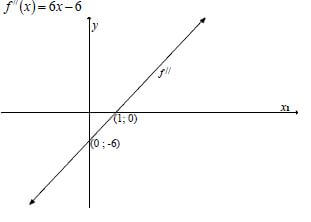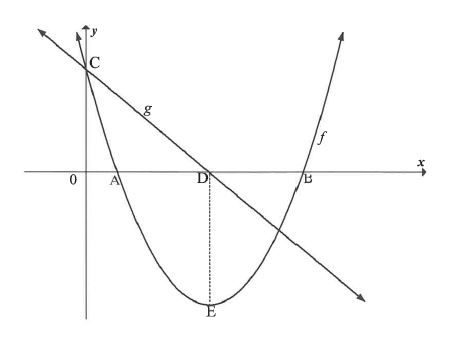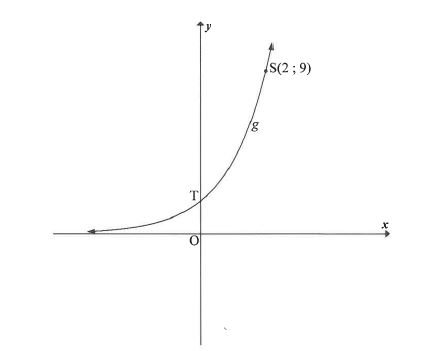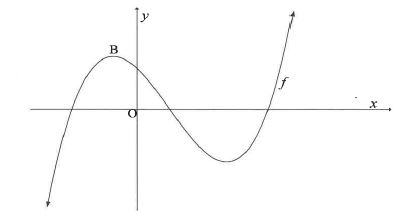Adele
VISUAL ARTS PAPER 1 GRADE 12 MEMORANDUM - NSC PAST PAPERS AND MEMOS FEBRUARY/MARCH 2018
VISUAL ARTS
PAPER 1
GRADE 12
NSC PAST PAPERS AND MEMOS
FEBRUARY/MARCH 2018
INSTRUCTIONS AND INFORMATION
Read the following instructions carefully before commencing marking:
- These marking guidelines consist of EIGHT answers. Candidates had to answer any FIVE questions for a total of 100 marks.
- It is MOST IMPORTANT that allowance is made for the candidates in many instances:
- Candidates must be given credit for providing their own opinions and ideas in answers.
- Credit must be given for lateral thinking.
- Arguments and statements must be well-reasoned and qualified with reference to specific factors.
- Questions and subsections must be numbered clearly and correctly. Bullets usually act as guidelines to help structure candidates' answers.
- Information and artworks discussed in one answer must not be credited if repeated in other answers, but artworks may be cross-referenced.
- Where applicable, candidates must name the artist and title of each artwork. Only ONE mark is allocated for the correct artist and title of work.
- Where applicable, candidates may discuss both two- and three-dimensional artworks in any answer.
- Remember that many candidates will be discussing these examples, never having seen them before. Markers therefore cannot expect factual, academic information. They should draw upon their own experiences, cultures and interpretations of the artworks, within the context of the question. Therefore, markers need to be open-minded and flexible in the marking process.
GENERAL INFORMATION FOR MARKERS
- These marking guidelines are to serve as a guideline for markers and a teaching tool. Therefore, the marking guidelines for certain questions are in greater depth, so that the information may be used as learning material. Other parts of the marking guidelines may merely be a suggested guideline.
- NOTE: Markers are encouraged to reward candidates for what they know, rather than penalise them for what they don't know.
- Although the information for the questions is given in point form, candidates must use an essay/paragraph format discussing their information in a holistic manner.
- Candidates must answer all the questions in FULL SENTENCES or PARAGRAPHS, according to the requirements of each question. Answers in point form cannot receive full marks. Full marks cannot be given if the title or artist is incorrect.
- Markers must refer to the Visual Arts CAPS document page 45 for a guideline to assess the levels of achievement.
Assessing candidates' ability to analyse and respond to examples of visual culture
ACHIEVEMENT | TOPIC 3: VISUAL CULTURE STUDIES ✔ |
7 |
|
6 |
|
5 |
|
4 |
|
3 |
|
2 |
|
1 |
|
MEMORANDUM
CANDIDATE MUST ANSWER ANY FIVE QUESTIONS.
The following mark allocation must be adhered to when only ONE artwork/artist has been discussed instead of TWO:
- 6 marks (max 3)
- 8 marks (max 5)
- 10 marks (max 6)
- 12 marks (max 7)
- 14 marks (max 8)
- 20 marks (max 12)
Due to the colour differences of the question papers from the different provinces, the provinces have to adapt the marking guidelines for interpretation.
QUESTION 1: THE VOICE OF EMERGING ARTISTS
1.1 Candidates must compare the different approaches of the artists by using the following guidelines in their discussion:
- Subject matter:
FIGURE 1a:
This is an everyday township scene portraying a busy street scene. The township is seen in the background, the curved road divides the foreground from the background. A large bus is placed in the centre of the artwork. Different pedestrians are seen crossing the road, standing on the pavement and at the bus stop.
FIGURE 1b:
This painting portrays the exterior of an exhibition space. The two art collectors are placed in the composition on the outside of a building. They appear very static and formal.
- Influences:
FIGURE 1a:
Bester uses his surroundings and everyday scenes of the township. He also collected and recycled debris and junk from junkyards and used it in his art works. This is a social issue addressed by Bester.
FIGURE 1b:
Influenced by Pop Art, photography and hard-edge painting.
- Line, shape and colour:
FIGURE 1a:
This is a bright and colourful painting. Various lines and shapes are seen throughout the busy composition. The geometric lines of the bus, bus stop, houses and pedestrian bridge contrasts with the curved line of the tarred road. The line of the horizon is formed in the background behind the houses. The picture plane is dominated by the blue colour of the road and the sky. He uses bright blues and oranges that contrast as well as red and green. Arbitrary colours are used.
FIGURE 1b:
Simplified, hard-edged shapes are used. Horizontal and vertical lines create stability in the composition. The shapes of the two human figures contrast with the formal geometric shapes of the garden and building. The vertical shapes of the two human figures, tree, totem pole and sculptures contrasts with the formal geometric shapes of the garden, pavement and building. The pale saturated blue sky contrasts with the neutral earthy colours of the foreground. The pink dress of the lady contrasts with the greenish colours of the sculptures, tree and garden.
- Placements of the figures and buildings/structures:
FIGURE 1a:
This is a scene with a pedestrian crossing, pavement, a bus dropping off people at a bus stop, a pedestrian bridge to the left of the scene, a shelter at the bus stop, some lorries and houses in the background and several human figures placed randomly. Some pedestrians are crossing the road; others are getting off the bus on their way home. Three uniformed figures are under a roof and facing the road at the bus stop
FIGURE 1b:
The stiff figures are static and formal on a paved area with a flat roofed building. They are surrounded by their possessions. A profile view of a middle-aged man is seen in a brown suit standing stiffly with his fists clenched while a full-figured matron like female in a robe, held closed with one arm, strikes a sensual pose that is gracious and confrontational. She faces forward and her eyes staring straight ahead. The façade of the modern building has two large glass windows. A totem pole and tree are seen to the right of the composition. Two sculptures are placed in the centre of the composition. The one in front of the male figure and the second one more to the back closer to the building.
- Style of painting:
FIGURE 1a:
Bester uses an expressive but figurative style of painting.
FIGURE 1b:
Hockney uses a stylised, hard-edged style. Smooth paint is applied in almost flat areas.
- Mood/Atmosphere:
FIGURE 1a:
This is a documentation of a friendly and happy everyday scene in a township. Bright colours create a busy atmosphere. Everyone is carrying on with their business of the day.
FIGURE 1b:
This painting is like a portrait study of these art collectors. A serene, static, quiet and calm atmosphere prevails. A formal and serious feeling is created.
Candidates cannot receive full marks if no comparison is made. Markers must use the descriptive rubric to guide mark allocation. (8)
1.2 Candidates must write an essay on ONE South-African artist that depicts his/her surroundings and own experiences from everyday life. They can refer to the following:
- Subject matter
- Influences
- Art elements
- Composition
- Style
- Possible meanings/messages (12) [20]
QUESTION 2: SOUTH AFRICAN ARTISTS INFLUENCED BY AFRICAN AND/OR INDIGENOUS ART FORMS
Karel Appel said that his emotional expressions occupy a middle position between order and chaos. |
2.1 Candidates must discuss the statement above by referring to African and other influences in FIGURE 2a and FIGURE 2b.
They may include the following:
- Shapes and symbols:
FIGURE 2a: Irregular shapes created by colour, become angry faces. Finding meaning in the expressionistic application of paint, Appel used harsh outlines to emphasise what he saw in the muddle of colours. These shapes of colours symbolise faces. Hard outlines, stylisation, naïve symbolic shapes and distortion, shows clear characteristics of Expressionism.
FIGURE 2b: Squares, and rectangles are put together to form expressive figures. It symbolises a large figure with a smaller figure on her lap and two smaller figures on either side of the large figures. Ethnic patterns can be seen on the clothing of the figures. Walter Battiss was influenced by the simplified shapes and symbols used by the Khoi-San artists, as can be seen in the tiny figures in the background. Decorative Ndebele patterns are used on the figures' clothing. Simplified figures and distortions indicate the influence of Expressionism. The end result has a Fauvistic feel to it reminding us of the paintings by Matisse.
- Art elements:
FIGURE 2a: The primary colours, red, blue and yellow dominate the picture plane. Purple, as the complimentary of yellow is used to create a contrasting background. Green as the complimentary of red is also used to create the faces. Balance is created through the use of the bright yellow on either side of the two dominating faces. The use of impasto and arbitrary colours give an abstracted quality to the painting
FIGURE 2b: The large, green figure in the centre forms the focal point. aïve lines are used to create the arms and face. Blue and orange, and green and red are used to form contrasts in the painting. Bright yellow used on the left, centre and right of the painting, forms a symmetrical balance. Texture is obtained by the numerous tiny, ant-like figures in the background.
- Possible meanings/messages:
FIGURE 2a: The message can be derived from the title, 'Angry Landscape'. The harsh colours and impasto paint is expressive and angry. The facial expressions of the two heads also portray anger indicated by bared teeth and large eyes.
FIGURE 2b: The title of the painting indicates a mother being the head of a tribe. On her lap is a childlike figure and on either side a female figure and a small male figure. This makes her the leader. It can also symbolise the fertility of women in general. The many tiny figures in the background are symbolic of the tribe. The message of a woman bearing children and being the nurturer of a nation is universal. (8)
2.2 Candidates must discuss ONE artwork by ONE artist whose works are/were influenced by Africa.
They must use the following guidelines in their answer:
- Subject matter
- Influences
- Symbols
- Style
- Possible meanings/messages (12) [20]
QUESTION 3: SOCIO-POLITICAL ART, INCLUDING RESISTANCE ART OF THE 1970s AND 1980s
As a voice against political and/or social injustices in society, artists use a combination of media and symbolism to convey a deeper message. |
3.1 Candidates must analyse FIGURE 3a and FIGURE 3b to comment on how these artists conveyed their voices of resistance.
They may use the following guidelines:
- Subject matter:
FIGURE 3a: In this artwork the mineworkers of South Africa and their lifestyles are portrayed. An image of a shanty township is illustrated in the background. On the left side of the artwork is an image of a steam train. In the centre of the artwork is the structure of a mine with the wheel of the cage taking the men down to the underground.
FIGURE 3b: In the centre of the painting is an image of a male figure dressed in a sleeveless vest and blue pants. He is lying on the lap of a female dressed in camouflage clothing. She wears glasses and a headscarf. In the background, composed in a semi-circle, are images of red roses, a fist and the barrels of 4 guns. In the top right corner of the artwork are the legs of a person, and just below an outlined image of a human figure. In the centre, on the right side are blurred images of presumably buildings.
- Media and technique
FIGURE 3a: Collage clippings of photographs and sketches were put together to create a layered composition, creating distorted images. He often paints or draws over his paper clippings (collẽ). The background is a painted landscape. A cut-out photograph of a locomotive engine and its carriages can be seen emerging from the horizon line. Many of the portraits are drawn and painted in a naïve and simplistic manner.
FIGURE 3b: The artist used oil paint and combined this with spray paint and stencilling. This is evident in the images of the guns and roses. Interesting vertical lines create texture in the background.
- Symbolism:
FIGURE 3a: The steam train symbolises either the transport of the mine worker or the transport of the raw materials excavated by the mine. The small structures in the background could represent the hostels that the mine workers had to live in, or the low cost housing in squatter camps. All the figures represent the life of the mine worker.
FIGURE 3b: The two figures symbolise a Pieta. The red roses symbolise hope, love, forgiveness or sadness. The guns are a symbol of violence and death.
- Possible meanings/messages:
FIGURE 3a: The use of photographs and clippings of drawings becomes a distorted, dreary scene where people march in and out to the mines to work. The artwork is a voice against the state of the working conditions of the labourers at the mines. The composition becomes fragmented scenes of life on the mines.
FIGURE 3b: The artwork evokes a feeling of sadness as the mother is holding her son who has died. It reminds one of the PIETA of Michelangelo where mother Mary holds Jesus on her lap after he has been taken from the cross. The boy could have been killed in the city during demonstrations or during the violence between the different gangs of urban squatter camps. (8)
3.2 Candidates must discuss the work of any TWO South African artists who use their art to convey messages of social and/or political issues.
They must use the following in their answer:
- Subject matter
- Influences
- Art elements
- Media and technique
- Possible meanings/messages (12) [20]
QUESTION 4: ART, CRAFT AND SPIRITUAL WORKS MAINLY FROM RURAL SOUTH AFRICA
The traditional African mask has always been used as a deeply spiritual expression for cultural and religious ceremonial reasons. Contemporary artists use the mask in many different ways. |
4.1 Candidates must discuss how the traditional mask has been reinterpreted by referring to FIGURES 4a-d.
They may refer to the following:
- Use of recycled materials
FIGURE 4a: A piece of wood is carved to become a mask.
FIGURE 4b: Wooden carved mask with found material for the hair. The artist has juxtaposed the African mask against modern dress as seen in the photograph.
FIGURE 4c: He uses recycled materials to create his mask. He uses a gasoline/petrol canister. The mask also has rope, a woven basket, a key, pipe, metal clamp and shells for the eyes.
FIGURE 4d: Made from found objects and recycled material sourced from the streets of Nairobi. Material is recycled and repurposed to form a web like mask.
- Techniques
FIGURE 4a: The mask is carved by a specific person in the community. The craft is passed down in the family. Colour is applied after the mask had been shaped and been completed.
FIGURE 4b: Carved mask juxtaposed against modern dress. The photograph becomes the artwork.
FIGURE 4c: The mask (readymade) has been constructed from a petrol canister and found objects like a woven basket, keys, pipe, metal clamp, rope and shells.
FIGURE 4d: The photograph shows the portrait of a man with a mask on. Both the mask and the portrait become the artwork. The mask is constructed from found objects i.e. wire, nails, bottle top and metal strips.
- Possible meanings/messages
FIGURE 4a: African masks are used in rituals and ceremonies. They represent spirits of animals, ancestors, mythological heroes, mythological values or a form of honouring of a person in a symbolic way. The traditional African mask is worn during celebrations, dances and festivities and ritual ceremonies commemorating social and religious events. They are more often than not part of a unified experience, so while we see them as sculptural forms they can also be considered as a form of performance art, and understanding their function within this event is essential to appreciate their cultural, symbolic and aesthetic significance. African masks are high in demand from art collectors and museums the world over reworking their archival collections to present masks in a new and vibrant format which focus on the beauty and variety of form of the sculpture.
FIGURE 4b: There is a combination of Western society as seen in the suit and the African mask representing old African heritage. It addresses the idea of colonialisation.
FIGURE 4c: The mask represents the consumer society/ throw-away society influencing the traditional as seen in the woven head piece.
FIGURE 4d: This construction of found objects has a light and delicate feel to it. The use of metal parts (wire, bottoms of tins, small metal strips and parts) that reflect light makes it a modern and fashionable piece. The different interesting found parts and objects are arranged to form features of a face. The artist could have been influenced by European art movements for e.g. Cubism, Expressionism and/or Surrealism. This mask could be worn by a model on a fashion runway as part of an outfit or worn as an accessory. (8)
4.2 Candidates must analyse the work of TWO South-African artists who represent rural art, crafts and/or spirituality.
- Influences
- Art elements
- Media and techniques
- Possible meanings/ messages (12) [20]
QUESTION 5: MULTIMEDIA AND NEW MEDIA – ALTERNATIVE CONTEMPORARY AND POPULAR ART FORMS IN SOUTH AFRICA
In the Bible, the Tower of Babel was a tower built up to the heavens by rich, corrupt and materialistic people. God punished their pride by tearing down the tower and sentencing them all to speak in different languages. |
5.1 Candidates must discuss Minujín 's artwork in FIGURE 5a by referring to the following guideline:
- The significance of using books from around the world
The artist collected 30 000 books from different countries and arranged them in a spiral tower. Books represent knowledge, education and language. The books were donated by readers, libraries and over 50 Embassies.
- The size of the work
This work is done on a large scale and the tower rises up in the air. The large scale might represent all languages of the world. It spirals up 25 meters into the air allowing visitors to view the city from above.
- Display of the artwork in a public space
It becomes part of the urban space and is accessible to everyone visiting the space. It is not isolated in an art gallery or museum.
- Use of site
The installation was placed in a public space (San Martin square) in order for the spectators to walk up the ramp to make them aware of the origins of different languages.
- Interaction of the viewer
The spectator can walk along the spiral form to the top of the tower.
For teachers: When the visitors ascend the tower they hear music composed by Minujín and the artist repeating the word 'book' in many languages. Once dismantled the literary enthusiasts will be invited to pick one book to take home with them and the remaining books will be called the Library of Babel.
- Possible messages/meanings
She wants everyone to be part of a whole (unified). Also that we can communicate through books and spread a message through the written word. The unification of the written word in one location is reminiscent of the original Tower of Babel, where everyone spoke the same language. (8)
5.2 Artists often portray their own interpretation of stories and myths and use different material and techniques to tell a story.
Candidates must discuss ONE artwork from TWO different artists who use unconventional/ interesting media and techniques to tell a story.
They must use the following guidelines:
- Line, shape and colour
- Media and techniques
- Possible meanings/messages (12) [20]
QUESTION 6: POST-1994 DEMOCRATIC IDENTITY IN SOUTH AFRICA
Zyma Amien's artwork pays homage to her mother and grandmother who worked in the textile industry. The textile industry has the reputation that they exploit women by paying them a minimum wage for long hours' work. |
6.1 Candidates must discuss how Zyma Amien has portrayed in this exploitation in her work by considering the following:
- Description of the work
Amien pays homage to her mother and grandmother who worked in the textile industry. There are three white gauze overalls hanging against a white wall and three black sewing machines of different sizes are placed at the bottom of each overall. The sewing machines forcibly 'pin' the overalls to the floor reminiscent of those worn by female workers.
- Colour
The white gauze overalls are juxtaposed against the black sewing machines. White is symbolic of purity and peace and the black symbolic of the industrial oppression.
- Symbolism
Paying homage to someone is to give honour and respect. The title of the artwork evokes a feeling of sadness. The white overalls are symbolic of her mother and grandmother. Usually overalls are not white and made from heavy durable material whereas these overalls are white and made from a soft and feminine material. The sewing machine could be a reference to the male gender and could symbolise oppression seen in the textile industry. (6)
6.2 Like Zyma Amien, many post-1994 democratic artists' work has developed from their own personal histories.
Candidates must discuss the work of any TWO relevant South African post 1994 democratic artists who explore their own identities.
They may refer to the following guidelines:
- Subject matter
- Influences
- Art elements
- Composition
- Style
- Possible meanings/messages (14) [20]
QUESTION 7: GENDER ISSUES: MASCULINITY AND FEMININITY
| Contemporary society has a more tolerant approach to gender issues, which has allowed artists to break with stereotypes. |
7.1 Candidates must discuss why they think FIGURE 7a and 7b have broken with stereotypes.
Candidates can use the following guidelines to aid their response:
- Visual appearance/body language
FIGURE 7a: The male is portrayed as a soft, shy young man looking down at his hand. Introverted and self-absorbed.
FIGURE 7b: The young man is looking at the viewer with self-confidence and bravado. Standing with his hands on his hips, he shows off his muscular, tattooed body. He is placed as if on a stage and is prancing and preening for the adulation of the viewer.
- Style and technique
FIGURE 7a: An impressionistic feel is given to the painting by the use of light and soft colours. The work is gestural, expressive, and painterly. Short brushstrokes and the use of spray paint reminds one of graffiti. The soft colours give a feminine image of the young man.
FIGURE 7b: Bold, realistic colours are used. The detail given to the figure almost reminds one of a photograph. Super realistic, meticulous application of paint with no visible brushstrokes. The background reminds us of wall paper which is very decorative and two-dimensional. The motifs of the wallpaper seem to be repeated in the designs of the tattoos. The realistic use of oil paint is almost like a photograph.
- Mood and atmosphere
FIGURE 7a: A very sad tranquil mood is created. The figure seems very relaxed and reserved and not aware of the viewer.
FIGURE 7b: Happy, jovial and playful atmosphere is created by the bright colour and decorative pattern on both the body and the background.
- Interpretation of gender issues
Candidates' own interpretation of gender issues and motivation thereof can be accepted. (10)
7.2 Society has prejudiced ideas on masculinity and femininity.
Candidates must debate their viewpoint of this issue in a discussion of the work of TWO artists who commented on gender aspects in their work.
They must use the following as a guideline:
- Subject matter/Themes
- Influences
- Media and techniques
- Style
- Possible meanings/messages (10) [20]
QUESTION 8: ARCHITECTURE IN SOUTH AFRICA
Francois van der Merwe Architects and PKA International Architects designed an intelligent green-star-rated government building in Tshwane that combines both the new and the old. A portion of the Agrivaal building was preserved and the new building 'clips' into the old building, therefore protecting South Africa's heritage. |
8.1 Candidates must analyse any TWO buildings they have studied this year, by answering the following:
- Do you think it was a good idea of PKA International Architects to incorporate part of the old Tshwane building into the new design for the Agrivaal headquarters? Substantiate your answer by referring to your own examples. Yes, because heritage is preserved and it creates a sense of the history/sense of the past. Old buildings are often built using beautiful traditional materials such as solid woods, old brick, sandstone, marble, mosaic work etc. Candidates don't need to agree with the statement as long as they substantiate their response.
- What structures have your chosen architects used in their buildings? Candidates own information to be given with substantiation.
- Do you think that architects should maintain parts of the old building when building/designing a new structure? Substantiate your answer. Yes, and only if the maintained part of the building has historical value. Often a design has to adjust to the original design of the historical building. Candidates could incorporate old and new building styles/materials etc. Candidates own information to be given with substantiation.
- Does your selected building reflect South Africa's heritage? Substantiate your answer. Candidates own information to be given with substantiation.
- Materials Candidates own information to be given with substantiation.
- Style Candidates own information to be given with substantiation.
- Possible influences Candidates own information to be given with substantiation. [20]
TOTAL: 100
PHYSICAL SCIENCES: CHEMISTRY PAPER 2 GRADE 12 MEMORANDUM - NSC PAST PAPERS AND MEMOS FEBRUARY/MARCH 2018
PHYSICAL SCIENCES: CHEMISTRY
PAPER 2
GRADE 12
NSC PAST PAPERS AND MEMOS
FEBRUARY/MARCH 2018
MEMORANDUM
QUESTION 1
1.1 C ✔✔ (2)
1.2 D ✔✔ (2)
1.3 B ✔✔ (2)
1.4 C ✔✔ (2)
1.5 B ✔✔ (2)
1.6 B ✔✔ (2)
1.7 B ✔✔ (2)
1.8 C ✔✔ (2)
1.9 A ✔✔ (2)
1.10 D ✔✔ (2) [20]
QUESTION 2
2.1
2.1.1 A ✔ (1)
2.1.2 B ✔ (1)
2.1.3 D ✔ (1)
2.1.4 D✔ (1) [4]
2.2
2.2.1 Butanal✔ (1)
2.2.2
- 5-ethyl-6,6-dimethyloctan-3-ol
OR/OF - 5-ethyl-6,6-dimethyl-3-octanol (4)
Marking criteria:
- Stem, i.e. octan.✔
- Correct functional group, i.e. -ol.✔✔
- Two methyl groups and one ethyl group.✔
- Correct numbering of substituents and functional group ✔
IF:
- Any error e.g. hyphens omitted and/or incorrect sequence: Max..3/4
2.3 Compounds with the same molecular formula, ✔ but different positions of the side chain/substituents/functional groups on parent chain. ✔ (2)
2.4
2.4.1 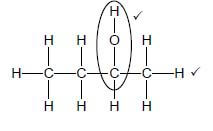 (2)
(2)
Marking criteria:
- Whole structure correct: 2/2
- Only functional group correct: Max.: 1/2
IF:
- More than one functional group: 0/2
2.4.2  (2)
(2)
Marking criteria:
- Whole structure correct: 2/2
- Only functional group correct : Max.: 1/2
IF:
- More than one functional group:
2.4.3 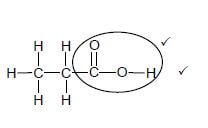 (2)
(2)
Marking criteria:
- Whole structure correct: 2/2
- Only functional group correct : Max.: 1/2
IF:
- More than one functional group: [17]
QUESTION 3
3.1 150 kPa✔ (1)
3.2
3.2.1 The temperature at which the vapour pressure equals atmospheric/external pressure. ✔✔( 2 or 0) (2)
3.2.2 55 °C ✔ (1)
3.3
3.3.1 Z ✔ (1)
3.3.2
- Carboxylic acids have, in addition to London forces and dipole-dipole forces, two sites for hydrogen bonding between molecules. ✔
OR
Carboxylic acids can form dimers due to strong hydrogen bonding between molecules. - Alcohols have, in addition to London forces and dipole-dipole forces, one site for hydrogen bonding between molecules. ✔
- Ketones has, in addition to London forces, dipole-dipole forces between molecules. ✔
- Intermolecular forces in carboxylic acids is the strongest./Most energy needed to overcome/break intermolecular forces in ethanoic acid. ✔ (4)
3.3.3
- Propanone✔
OR - Propan-2-one
OR - 2-propanone (1) [10]
QUESTION 4
4.1 The chemical process in which longer chain hydrocarbon molecules are broken down to shorter more useful molecules. ✔ (2)
4.2
4.2.1 III ✔ (1)
4.2.2 II ✔ (1)
4.2.3 I ✔ (1)
4.3
4.3.1 Heat/Light /UV light ✔ (1)
4.3.2 P or S ✔ (1)
4.3.3 Ethene ✔ (1)
4.3.4 C8H18 ✔✔ (Correct Structural formula : 1/2) (2)
4.3.5 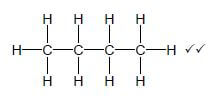 (2)
(2)
Marking criteria:
- Whole structure correct: 2/2
- 4 C atoms in chain: Max : 1/2
- Correct condensed formula 1/2
4.3.6  (2)
(2)
Marking criteria:
- Whole structure of alkene/haloalkane correct: 2/2
- Only functional group correct: 1/2
- Correct condensed structure CH3CH=CHCH3 1/2 [14]
QUESTION 5
5.1 ONLY ANY ONE OF:
- Change in concentration ✔ of a reactant/product per unit time.
- Rate of change in concentration. ✔✔
- Change in amount/number of moles/volume/mass of products/reactants per (unit) time ✔
- Amount/number of moles/volume/mass of products formed OR reactants used per (unit) time. ✔ (2)
5.2 More than ✔
- Accept/
Equal to (1)
5.3 Graph of average reaction rate versus volume of Na2S2O3(aq) (3)
(3)
Marking criteria | |
Any 3 points correctly plotted. | ✔ |
All (5) points correctly plotted. | ✔ |
Straight line drawn. | ✔ |
5.4
5.4.1 Marking criteria:
- y axis: 2,5 x 10-2 s-1 ✔
- Dotted line drawn from the y-axis to the x-axis as shown. ✔
- V = 28 to 30 cm3 ✔ (3)
5.4.2 Criteria for conclusion:
- Dependent and independent variables correctly identified. ✔
- Relationship between the independent and dependent variables correctly stated ✔
Examples:
- Reaction rate of reaction increases with an increase in concentration/volume of sodium thiosulphate.
- Reaction rate decreases with a decrease in concentration/volume of sodium thiosulphate.
- Reaction rate is (directly) proportional to concentration/volume of sodium thiosulphate.
5.5
- More( Na2S2O3) particles per unit volume. ✔
- More effective collisions per unit time./Higher frequency of effective collisions. ✔
- Increase in reaction rate.✔
5.6
| OPTION 1 n(S)produced/gevorm = m M = 1,62 32 = 0,0506 mol n(Na2S2O3) = n(S) = 0,0506 mol | Marking criteria:
|
OPTION 2 [Range: 7,90 to 8,06] | |
(4) [18]
QUESTION 6
6.1
6.1.1 When the equilibrium in a closed system is disturbed, the system will re-instate a new equilibrium by favouring the reaction that will oppose the disturbance. ✔✔ (2)
6.1.2
- Percentage yield increases with an increase in temperature. ✔
- Forward reaction is favoured.
- Increase in temperature favours an endothermic reaction. (3)
6.1.3 When the pressure increases, the reaction that leads to a decrease in the number of moles will be favoured. ✔✔
Accept
- When the pressure increases, the yield increases ✔ because the equilibrium position shifts to the right. ✔ (2)
6.1.4 I ✔✔ (2)
6.2 Mark allocation
- Substitution of 36,5 g∙mol-1 in n = m/M . ✔
- Change n(HCℓ) = initial - equilibrium ✔
- USING ratio: 4 : 1 : 2 : 2 ✔
- Equilibrium: n(O2) & n(H2O) & n(Cℓ2) = initial ± change ✔
- Divide by volume (0,2 dm3) ✔
- Correct Kc expression (formulae in square brackets). ✔
- Substitution of reactant concentrations ✔
- Substitution of product concentrations.✔
- Final answer: 13,966 to/tot 18,72 ✔
Range: 13,966 to/tot 18,72
OPTION 1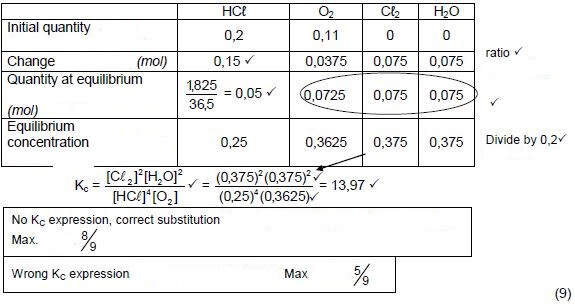 (9)
(9)
OPTION 2:
- n(HCℓ)equilibrium = m/ M = 1,825/36,5 = 0,05 mol
n(HCℓ)reacted= 0,2 - 0,05 = 0,15 mol ✔- n(O2)reacted = ¼n(HCℓ)reacted= ¼ x 0,15 = 0,0375 mol
n(Cℓ2)formed = ½n(HCℓ)reacted = ½ x 0,15 = 0,075 mol
n(H2O)formed = ½n(HCℓ)reacted/= ½ x 0,15 = 0,075 mol
Using ratio ✔
- n(O2)reacted = ¼n(HCℓ)reacted= ¼ x 0,15 = 0,0375 mol
- n(O2)equilibrium = 0,11 - 0,0375 = 0,0725 mol
n(Cℓ2)equilibrium = n(H2O)equilibrium = 0,075 mol
c(O2)equilibrium = n/V = 0,0375/0,2 = = 0,3625 mol∙dm-3
c(Cℓ2)equilibrium/= c(H2O)equilibrium = n/V
= 0,075/0,2 = 0,375 mol∙dm-3 - Kc = [H2O]2[CL2]2 = (0,375)2(0,375)2 = 13,97
[HCL]4[O2] (0,25)4(0,3625)
No KC expression, correct substitution: Max. 8/9
Wrong KC expression :Max. 5/9 (9)
CALCULATIONS USING CONCENTRATIONS
Mark allocation
- Substitution of/Vervanging van 36,5 g∙mol-1 n = m/ M
- Initial concentration of reactants: c(HCℓ) = 1,0 & c(O2) = 0,55 mol∙dm-3
- Change: c(HCℓ) = 0,75 mol∙dm-3 (initial - equilibrium)
- USING ratio : 4 : 1 : 2 : 2
- Equilibrium : c(H2O) = c(Cℓ2) = 0,3625 mol∙dm-3 (initial+change) and c(O2) = 0,3625 mol∙dm-3 (initial - change)
- Correct Kc expression (formulae in square brackets).
- Substitution of reactant concentrations
- Substitution of product concentrations.
- Final answer: 13,97
Range: 13,966 to 18,72
OPTION 3
- n(HCℓ)equilibrium = m/ M
= 1,825/36,5
= 0,05 mol
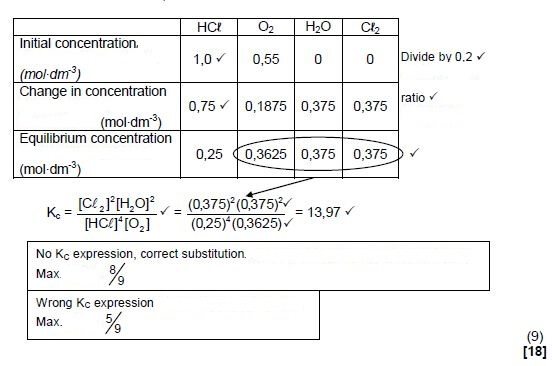
QUESTION 7
7.1
7.1.1
- H2O ✔
- HSO4 ✔ (2)
7.1.2
- Strong ✔
- Completely ionised (in water)✔ (2)
7.2
7.2.1 Marking Criteria:
- Formula/Formule: ca × Va = na /c = n
ca × Vb nb V - Substitute 0,15 x 24 OR/OF 0,15 x 0,024 ✔
- Use 26 cm3 OR 0,026 dm3 ✔
- Use mole ratio : 1:2 ✔
- Final answer : 0,28 mol∙dm-3 ✔ (0.2769… mol∙dm-3)
OPTION 1
ca × Va = na
ca × Vb nb
0,15 × 24 = 1
cb × 26 2
c(NaOH) = 0,28 mol.dm3
OPTION 2
n(H2SO4) = cV
= (0,15)(0,024)
= 3,6 x 10-3 mol
n(NaOH) =2(3,6 x 10-3)
= 7,2 x 10-3 mol
c = n
V
= 7,2 x 10-3
0,026
= 0,28 mol∙dm-3 (5)
7.2.2 Marking Criteria
- Calculate n(NaOH): 0,02 x 0,28✔
- Calculate n(H2SO4): 0,03 x 0,15 ✔
- Use ratios: n(H2SO4) = ½n(NaOH) ✔
- n(H2SO4)excess = n(H2SO4)initial - n(H2SO4)used = 0,0045 - 0,0028 ✔
- Substitute 0,05 dm3 in c = n
V ✔ - Substitution 2 x 0,034 in 2[H2SO4] ✔
- Formula: -log[H3O+] OR Substitute: -log(0,068) ✔
- Final answer: 1,10 to/tot 1,167 ✔
| Option 1 | Option 2 |
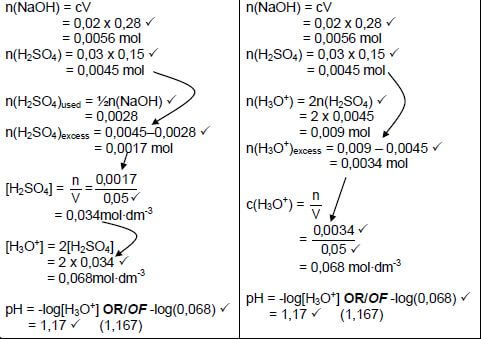 | |
(8)[17]
QUESTION 8
8.1
8.1.1 A substance that loses/donates electrons ( 2 or 0) ✔✔ (2)
8.1.2 Platinum/Pt ✔ (1)
8.1.3 Sn2+(aq)/tin(II) ions ✔ (1)
8.1.4
- Pt | Sn2+(aq) , Sn 4+(aq) || Ag+(aq) | Ag(s)
OR - Pt| Sn2+(1 mol∙dm-3) ,Sn 4+ (1 mol∙dm-3) || Ag+ (1 mol∙dm-3) | Ag(s)
ACCEPT - Pt| Sn2+ | Sn 4+ || Ag+ | Ag (3)
8.1.5
OPTION 1 E°cell = E°reduction - E°oxidation | Notes
|
| Option 2 Ag+(aq) + e- → Ag(s) 0,80V Sn2+(aq) → Sn4+(aq) + 2e- - 0,15V 2Ag+(aq) + Sn2+(aq) → Sn4+(aq) + 2Ag(s) 0,65V | |
(4)
8.2
8.2.1 Magnesium becomes smaller./Brown solid forms/Mg disappears/eaten away/Mg changes colour. ✔ (1)
8.2 2
- Cu2+ is a stronger oxidising agent ✔(than Mg2+) and will be reduced to ✔ Cu. ✔
OR - Mg is a stronger reducing agent (than Cu) and will reduce Cu2+ to Cu. (3) [15]
QUESTION 9
9.1
- The chemical process in which electrical energy is converted to chemical energy. ✔✔
OR - The use of electrical energy to produce a chemical change. (2)
9.2 B ✔ (1)
9.3
- Cu2+(aq) + 2e- → Cu ✔✔ (2)
Marking criteria
- Cu ← Cu2+(aq) + 2e- ( 2/2 ) Cu2+(aq) + 2e- ⇌ Cu ( 1 /2 )
Cu ⇌ Cu2+(aq) + 2e-( 0/2 ) Cu2+(aq) + 2e- ← Cu ( 0/2 ) - Ignore if charge omitted on electron.
- If charge (+) omitted on Cu2+
Max: 1/2
9.4
- % purity = m(Cu) × 100
m(Cu )impure
= 4,4 ×100
5
= 88% ✔ (4)
Marking criteria:
- Substitute 4,4 ✔
- Substitute 5 ✔
- x 100 ✔
- Final answer: 88% ✔ [9]
QUESTION 10
10.1
10.1.1 N2(g) + 3H2(g) ✔ → 2NH3(g) ✔ bal ✔
Notes:
- Reactants ✔ Products ✔ Balancing ✔
- Ignore if phases are omitted
- Ignore ⇌
- Marking rule/Nasienreël 3.9 (3)
10.1.2 (NH4)2SO4 ✔ (1)
10.1.3 Ostwald process ✔ (1)
10.1.4 Ammonium nitrate ✔ (1)
10.2
10.2.1
- The ratio of nitrogen (N), phosphorous (P) and potassium (K) in a certain fertiliser.✔
Accept :
- nitrogen, phosphorous and potassium ✔ (1)
10.2.2 Percentage fertiliser in the bag.✔ (1)
10.2.3 OPTION 1
- % K =5 ✔ x 22% ✔
12
= 9,17%
∴ m(N) = 9,17 × 10 kg
100
= 0,92 kg ✔
OPTION 2
- m(nutrients):
22/100 × 10 = 2,2 kg
∴ m(K) = 5/12 (2,2)
= 0,92 kg ✔ (4)
[12]
TOTAL: 150
PHYSICAL SCIENCES: CHEMISTRY PAPER 2 GRADE 12 QUESTIONS - NSC PAST PAPERS AND MEMOS FEBRUARY/MARCH 2018
PHYSICAL SCIENCES: CHEMISTRY
PAPER 2
GRADE 12
NSC PAST PAPERS AND MEMOS
FEBRUARY/MARCH 2018
INSTRUCTIONS AND INFORMATION
- Write your centre number and examination number in the appropriate spaces on the ANSWER BOOK.
- This question paper consists of TEN questions. Answer QUESTION 5.3 on the attached GRAPH PAPER. Answer ALL the questions in the ANSWER BOOK.
- Start EACH question on a NEW page in the ANSWER BOOK.
- Number the answers correctly according to the numbering system used in this question paper.
- Leave ONE line between two subquestions, for example between QUESTION 2.1 and QUESTION 2.2.
- You may use a non-programmable calculator.
- You may use appropriate mathematical instruments.
- You are advised to use the attached DATA SHEETS.
- Show ALL formulae and substitutions in ALL calculations.
- Round off your FINAL numerical answers to a minimum of TWO decimal places.
- Give brief motivations, discussions, et cetera where required.
- Write neatly and legibly.
QUESTIONS
QUESTION 1: MULTIPLE-CHOICE QUESTIONS
Various options are provided as possible answers to the following questions. Choose the answer and write only the letter (A-D) next to the question number (1.1-1.10) in the ANSWER BOOK, for example 1.11 D.
1.1 Which ONE of the following is the general formula of alkynes?
- CnH2n
- C2nH2n
- CnH2n - 2
- CnH2n + 2 (2)
1.2 The type of reaction that takes place when a carboxylic acid and an alcohol react in the presence of an acid:
- Addition
- Hydrolysis
- Substitution
- Esterification (2)
1.3 Which ONE of the following isomers has the LOWEST boiling point?
- CH3CH2CH2CH2CH2CH3
- CH3CH2C(CH3)2CH3
- CH3CH(CH3)CH2CH2CH3
- CH3CH2CH(CH3)CH2CH3 (2)
1.4 Which ONE of the reaction rate versus time graphs below best represents the reaction between magnesium and EXCESS dilute hydrochloric acid?  (2)
(2)
1.5 Which ONE of the following will NOT affect the equilibrium position of reversible chemical reactions?
- Temperature
- Catalyst
- Pressure
- Concentration (2)
1.6 The following equilibrium exists in pure water at 25 °C.
2H2O(ℓ) ⇌ H3O+(aq) + OH(aq) ∆H > 0
At this temperature, the pH = 7 and Kw = 1 x 10-14. The temperature of the water is now increased to 90 °C. Which ONE of the following is TRUE at the new temperature?
- pH = 7
- [H3O+] = [OH ]
- [H3O+][OH ] = 10-14
- [H3O+] = 10-7 mol∙dm-3 (2)
1.7 A hydrochloric acid solution is titrated against an ammonia solution. The balanced equation for the reaction is:
HCℓ(aq) + NH4OH(aq) → NH4Cℓ(aq) + H2O(ℓ)
Which ONE of the following gives the pH of the solution at the end point and the reason for this pH? (2)
| pH | REASON | |
| A | 3 | H3O+(aq) is formed during the ionisation of HCℓ(aq). |
| B | 5 | H3O+(aq) is formed during hydrolysis of NH (aq). |
| C | 7 | Neutralisation takes place at the end point. |
| D | 8 | OH-(aq) is formed during hydrolysis of NH4 (aq). |
1.8 A decrease in the oxidation number of an atom during a chemical reaction is known as …
- redox.
- oxidation.
- reduction.
- electrolysis. (2)
1.9 The two half-reactions below are used to construct a galvanic cell.
X+(aq) + e- ⇌ X(s) Eθreduction = + 0,15 V
Y2+(aq) + 2e- ⇌ Y(s) Eθreduction = - 0,15 V
Which ONE of the statements below is CORRECT when the cell is in operation?
- X+(aq) is reduced.
- Y(s) is reduced.
- X(s) | X+(aq) is the negative electrode.
- Electrons flow from X(s) to Y(s) in the external circuit. (2)
1.10 Which ONE of the following is CORRECT for the industrial preparation of sulphuric acid? (2)[20]
| PROCESS | CATALYST | |
| A | Ostwald | Platinum |
| B | Haber | Iron |
| C | Contact | Iron |
| D | Contact | Vanadium pentoxide |
QUESTION 2 (Start on a new page.)
The letters A to E in the table below represent six organic compounds.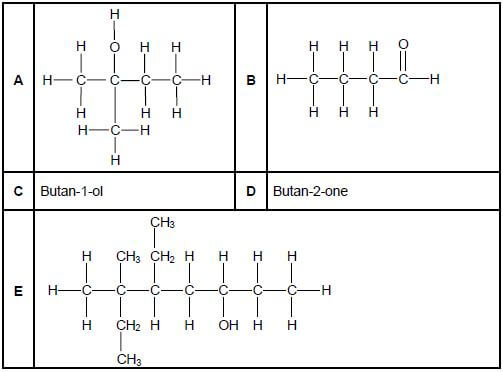
2.1 Write down the LETTER that represents EACH of the following:
2.1.1 A tertiary alcohol (1)
2.1.2 An aldehyde (1)
2.1.3 A ketone (1)
2.1.4 A functional isomer of compound B (1)
2.2 Write down the IUPAC name of:
2.2.1 Compound B (1)
2.2.2 Compound E (4)
2.3 Define positional isomers. (2)
2.4 Write down the STRUCTURAL FORMULA of:
2.4.1A positional isomer of compound C (2)
2.4.2 Compound D (2)
2.4.3The organic acid that will react with compound C to form butyl propanoate (2) [17]
QUESTION 3 (Start on a new page.)
Study the vapour pressure versus temperature graphs for three organic compounds, X, Y and Z, below which belong to different homologous series.
Atmospheric pressure is 100 kPa.
3.1 Write down the vapour pressure of compound Y at 90 °C. (1)
3.2 The graphs can be used to determine the boiling points of the three compounds.
3.2.1Define boiling point. (2)
3.2.2 Determine the boiling point of compound X. (1)
3.3 The homologous series to which the three compounds of similar molecular masses belong, were identified in random order as:
alcohol; carboxylic acid; ketone
3.3.1 Which compound (X, Y or Z) is the carboxylic acid? (1)
3.3.2 Explain the answer to QUESTION 3.3.1 by referring to the type of intermolecular forces in compounds of each of the homologous series above. (4)
3.3.3Compound X has three carbon atoms per molecule. Write down the IUPAC name of compound X. (1) [10]
QUESTION 4 (Start on a new page.)
Consider the incomplete equations for reactions I to IV below. P, Q, R and S are organic compounds.
4.1Define a cracking reaction. (2)
4.2 Write down the reaction number (I, II, III or IV) that represents EACH of the following:
4.2.1A cracking reaction (1)
4.2.2An addition reaction (1)
4.2.3 A substitution reaction (1)
4.3Write down:
4.3.1ONE reaction condition for reaction I (1)
4.3.2 The compound (P, Q, R or S) that represents an unsaturated hydrocarbon (1)
4.3.3 The IUPAC name of compound P (1)
4.3.4 The molecular formula of compound R (2)
4.3.5The structural formula of compound Q (2)
4.3.6The structural formula of compound S (2) [14]
QUESTION 5 (Start on a new page.)
ANSWER QUESTION 5.3 ON THE ATTACHED GRAPH PAPER.
Learners use the reaction between sodium thiosulphate and hydrochloric acid to investigate one of the factors that affects reaction rate. The balanced equation for the reaction is:
Na2S2O3(aq) + 2HCℓ(aq) → 2NaCℓ(aq) + H2O(ℓ) + SO2(g) + S(s)
The diagram below shows the experimental setup.
In the first experiment, 50 cm3 of the sodium thiosulphate solution is added to 100 cm3 of a 2 mol∙dm-3 dilute hydrochloric acid solution in a flask that is placed over a cross drawn on a sheet of white paper. The hydrochloric acid is in EXCESS.
The time taken for the cross to become invisible, when viewed from the top, is recorded.
The experiment is then repeated four times with different volumes of the sodium thiosulphate solution. The results obtained are shown in the table below.
EXPERIMENT | VOLUME OF | VOLUME OF | TIME (s) | AVERAGE RATE |
1 | 50 | 0 | 22,7 | 4,4 |
2 | 40 | 10 | 28,6 | 3,5 |
3 | 30 | 20 | 38,5 | 2,6 |
4 | 20 | 30 | 58,8 | 1,7 |
5 | 10 | 40 | 111,1 | 0,9 |
5.1 Define reaction rate. (2)
5.2 How does the concentration of the sodium thiosulphate solution used in experiment 2 compare to that used in experiment 5? Choose from MORE THAN, LESS THAN or EQUAL TO. (1)
5.3 Draw a graph of average reaction rate versus volume of sodium thiosulphate used on the attached GRAPH SHEET.
(ATTACH THIS GRAPH SHEET TO YOUR ANSWER BOOK.) (3)
5.4 Use the information in the graph to answer the following questions.
5.4.1Determine the volume of dilute sodium thiosulphate solution that needs to react in order for the cross to become invisible in 40 seconds.
USE DOTTED LINES ON THE GRAPH TO SHOW HOW YOU ARRIVED AT THE ANSWER. (3)
5.4.2Write down a conclusion for this investigation. (2)
5.5 Use the collision theory to explain the effect of an increase in concentration on reaction rate. (3)
5.6 The mass of sulphur produced in experiment 1 is 1,62 g. Calculate the mass of the sodium thiosulphate used in experiment 1. (4) [18]
QUESTION 6 (Start on a new page.)
6.1 A reversible gaseous reaction is allowed to reach equilibrium in a closed container at different temperatures and pressures.
The graph below shows the percentage yield for this reaction at 30 kPa as the temperature is increased.
Use the information in the graph above to answer the following questions.
6.1.1 State Le Chatelier's principle. (2)
6.1.2 The heat of reaction (∆H) for the forward reaction is POSITIVE. Use Le Chatelier's principle to explain this statement. (3)
The graph below show the percentage yield for this reaction as pressure changes at constant temperature.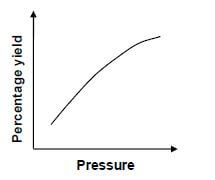
6.1.3 Explain the effect of an increase in pressure on the equilibrium position of a reaction. (2)
6.1.4 Which ONE of the following equations (I, II or III) represents the equilibrium above?
- 2A(g) + 3B(g) ⇌ 3C(g)
- A(g) + B(g) ⇌ 3C(g)
- A(g) + B(g) ⇌ 2C(g) (2)
6.2 A mixture of 0,2 moles of hydrogen chloride (HCℓ) and 0,11 moles of oxygen gas (O2) is sealed in a 200 cm3 flask at a certain temperature.
The reaction reaches equilibrium according to the balanced equation below:
4HCℓ(g) + O2(g) ⇌ 2Cℓ2(g) + 2H2O(g)
It is found that 1,825 g of hydrogen chloride is present at equilibrium.
Calculate the equilibrium constant, Kc, for this reaction at this temperature. (9) [18]
QUESTION 7 (Start on a new page.)
7.1 The balanced equation below represents the first step in the ionisation of sulphuric acid (H2SO4) in water:
H2SO4(ℓ) + H2O(ℓ) ⇌ H3O+(aq) + HSO-4 (aq)
7.1.1 Write down the FORMULAE of the TWO bases in the equation above. (2)
7.1.2 Is sulphuric acid a STRONG or a WEAK acid? Give a reason for the answer. (2)
7.2 Learners use the reaction of a 0,15 mol∙dm-3 sulphuric acid solution with a sodium hydroxide solution in two different experiments. The balanced equation for the reaction is:
H2SO4(aq) + 2NaOH(aq) → Na2SO4(aq) + H2O(ℓ)
7.2.1 They use 24 cm3 of H2SO4(aq) in a titration to neutralise 26 cm3 of NaOH(aq).
Calculate the concentration of the NaOH(aq). (5)
7.2.2 In another experiment, 30 cm3 of the H2SO4(aq) is added to 20 cm3 of a 0,28 mol∙dm-3 NaOH solution in a beaker.
Calculate the pH of the final solution. (8) [17]
QUESTION 8 (Start on a new page.)
8.1 A group of learners use the redox reaction below to construct an electrochemical cell.
Sn2+(aq) + 2Ag+(aq) → 2Ag(s) + Sn4+(aq)
8.1.1 Define a reducing agent in terms of electron transfer. (2)
8.1.2 Name a substance that should be used as electrode in the anode half-cell. (1)
8.1.3 Write down the NAME or FORMULA of the reducing agent. (1)
8.1.4 Write down the cell notation of the cell. (3)
8.1.5 Calculate the initial emf of this cell under standard conditions. (4)
8.2 In a separate experiment, the learners place magnesium ribbon in a beaker containing a blue solution of copper(II) sulphate. After a while the solution becomes colourless.
8.2.1 State ONE observable change in the beaker, besides a colour change of the solution, that the learners can make. (1)
8.2.2 Refer to the relative strengths of oxidising agents or reducing agents to explain why the solution becomes colourless. (3) [15]
QUESTION 9 (Start on a new page.)
The graph below represents the changes in mass that occur at electrode A and electrode B in an electrolytic cell during the purification of copper.
9.1 Define electrolysis. (2)
9.2 Which graph, A or B, represents the change in mass of the anode during electrolysis? (1)
9.3 Write down the equation of the half-reaction which takes place at the cathode of this cell.(2)
9.4 Use the information in the graph and calculate the percentage purity of the impure copper. (4) [9]
QUESTION 10 (Start on a new page.)
10.1 The diagram below shows processes involved in the production of fertiliser X and fertiliser Z.
Write down the:
10.1.1 Balanced equation for the formation of product Q (3)
10.1.2 FORMULA of fertiliser X (1)
10.1.3 NAME of process A (1)
10.1.4 NAME of fertiliser Z (1)
10.2 A 10 kg bag of NPK fertiliser is labelled 6 : 1 : 5 (22).
10.2.1 What is the meaning of NPK? (1)
10.2.2 What is the meaning of (22) on the label? (1)
10.2.3 Calculate the mass of potassium in the bag. (4) [12]
TOTAL: 150
DATA FOR PHYSICAL SCIENCES GRADE 12 PAPER 2 (CHEMISTRY)
TABLE 1: PHYSICAL CONSTANTS
| NAME | SYMBOL | VALUE |
| Standard pressure | pθ | 1,013 x 105 Pa |
| Molar gas volume at STP | Vm | 22,4 dm3∙mol-1 |
| Standard temperature | Tθ | Tθ 273 K |
| Charge on electron | e | e -1,6 x 10-19 C |
| Avogadro’s constant | NA | NA 6,02 x 1023 mol-1 |
TABLE 2: FORMULAE
n = m | n = N NA |
| c = n V or c = m MV | n = V Vm |
| caVa= na cbVb nb | pH= -log[H3O+] |
| Kw = [H3O+][OH-] = 1x10-14 at 298K | |
| Eθ cell = Eθ cathode – Eθ anode Eθ cell = Eθ reduction – Eθ oxidation Eθ cell = Eθ oxidising agent – Eθ reducing agent |
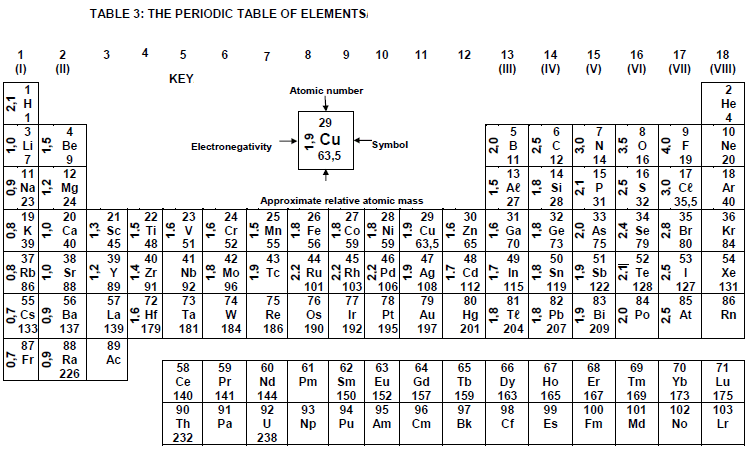

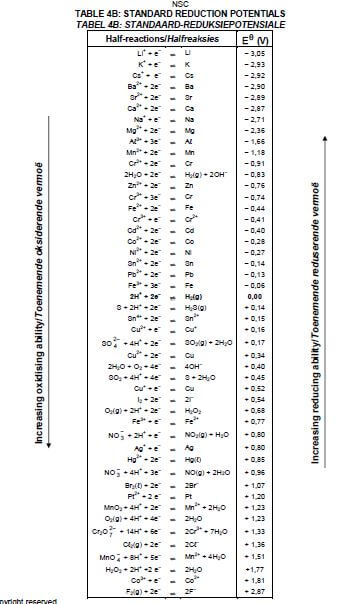
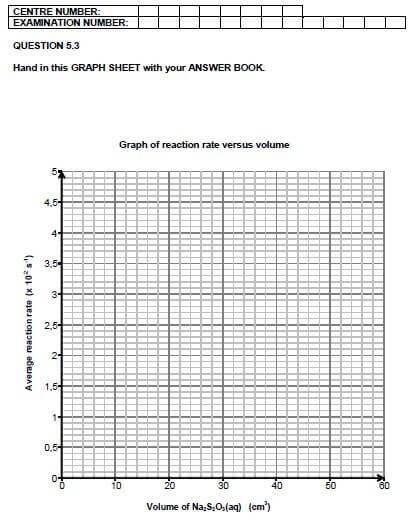
PHYSICAL SCIENCES: PHYSICS PAPER 1 GRADE 12 QUESTIONS - NSC PAST PAPERS AND MEMOS FEBRUARY/MARCH 2018
PHYSICAL SCIENCES: PHYSICS
PAPER 1
GRADE 12
NSC PAST PAPERS AND MEMOS
FEBRUARY/MARCH 2018
INSTRUCTIONS AND INFORMATION
- Write your examination number and centre number in the appropriate spaces on the ANSWER BOOK.
- This question paper consists of 11 questions. Answer ALL the questions in the ANSWER BOOK.
- Start EACH question on a NEW page in the ANSWER BOOK.
- Number the answers correctly according to the numbering system used in this question paper.
- Leave ONE line between two subquestions, for example between QUESTION 2.1 and QUESTION 2.2.
- You may use a non-programmable calculator.
- You may use appropriate mathematical instruments.
- You are advised to use the attached DATA SHEETS.
- Show ALL formulae and substitutions in ALL calculations.
- Round off your FINAL numerical answers to a minimum of TWO decimal places.
- Give brief motivations, discussions, et cetera where required.
- Write neatly and legibly.
QUESTIONS
QUESTION 1: MULTIPLE-CHOICE QUESTIONS
Various options are provided as possible answers to the following questions. Choose the answer and write only the letter (A–D) next to the question number (1.1–1.10) in the ANSWER BOOK, for example 1.11 D.
1.1 A constant horizontal force F is applied to a box resting on a horizontal, frictionless surface.
Which ONE of the following statements regarding force F is CORRECT? Force F will cause the box to move with …
- constant acceleration.
- constant velocity.
- constant kinetic energy.
- constant momentum. (2)
1.2 A block rests on a table. The table stands on a concrete floor. The normal force is represented by N, as shown in the diagram below. 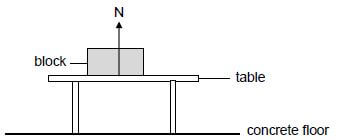
Which ONE of the following forces will form an action-reaction pair with the normal force (N)?
- Force of the block on the Earth
- Force of the block on the table
- Force of the table surface on the block
- Force of the block on the concrete floor (2)
1.3 A small stone is dropped from a height y above the ground. It strikes the ground after time t, as shown in the diagram below. 
Take upwards as the positive direction and the ground as zero reference. Ignore the effects of air resistance.
Which ONE of the following diagrams shows a correct position-time graph for the motion of the stone?  (2)
(2)
1.4 Learners perform an experiment using identical trolleys, each of mass m. The trolleys are arranged, as shown in the diagram below. They are initially at rest on a frictionless surface and are connected with a compressed, massless spring. 
When the spring is released it falls vertically down and the single trolley moves with momentum p to the left.
The magnitude of the momentum of the two trolleys moving to the right will be:
- 2p
- p
- 1p
2 - 1p (2)
4
1.5 A pendulum bob is released from point P above a horizontal surface. At the lowest point, Q, of its swing, it collides with a stationary block situated on a frictionless horizontal surface, as shown below. Ignore air friction. 
Which ONE of the following combinations of conservation laws can be used to calculate the speed of the bob at Q immediately before and after colliding with the block? (2)
SPEED AT Q | SPEED AFTER COLLISION | |
A | Conservation of mechanical energy | Conservation of linear momentum |
B | Conservation of linear momentum | Conservation of mechanical energy |
C | Conservation of mechanical energy | Conservation of mechanical energy |
D | Conservation of linear momentum | Conservation of linear momentum |
1.6 Which ONE of the statements below about the Doppler effect is CORRECT?
- The Doppler effect is only applicable to sound waves.
- The Doppler effect can be used to explain the expanding universe.
- Electrons are ejected from a metal surface by means of the Doppler effect.
- A stationary listener hears a lower pitch of the sound from a siren of an approaching vehicle because of the Doppler effect. (2)
1.7 The magnitude of the electrostatic force on a charge Q1 due to another charge Q2 is F. Both charges are now doubled without changing the distance between them.
The magnitude of the new electrostatic force on Q1 will be:
- F
2 - 2F
- 4F
- 6F (2)
1.8 Four identical bulbs, P, Q, R and S, are connected to a cell in a circuit, as shown below. The cell has negligible internal resistance. 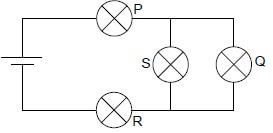
Which ONE of the following statements about the brightness of bulbs P, Q, R and S is CORRECT?
- P burns brighter than R.
- S and Q burn brighter than P and R.
- P and R burn brighter than S and Q.
- ALL the bulbs burn with the same brightness. (2)
1.9 Which ONE of the energy conversions below takes place when a DC motor is in operation?
- Kinetic to electrical
- Heat to mechanical
- Mechanical to electrical
- Electrical to mechanical (2)
1.10 In an investigation on the photoelectric effect, the graph of maximum kinetic energy (Ek(max)) versus frequency (f) was obtained for a certain metal, as shown below. 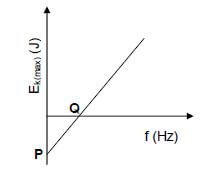
The intercepts, P and Q respectively, represent …
- Planck's constant and threshold frequency.
- work function and threshold frequency.
- threshold frequency and work function.
- threshold frequency and Planck's constant. (2) [20]
QUESTION 2 (Start on a new page.)
Two boxes, P and Q, resting on a rough horizontal surface, are connected by a light inextensible string. The boxes have masses 5 kg and 2 kg respectively. A constant force F, acting at an angle of 30oto the horizontal, is applied to the 5 kg box, as shown below. 
The two boxes now move to the right at a constant speed of 2 m∙s-1.
2.1 State Newton's First Law of Motion in words. (2)
2.2 Draw a labelled free-body diagram for box Q. (4)
Box P experiences a constant frictional force of 5 N and box Q a constant frictional force of 3 N.
2.3 Calculate the magnitude of force F. (6)
The string connecting P and Q suddenly breaks after 3 s while force F is still being applied.
Learners draw the velocity-time graph for the motion of P and Q before and after the string breaks, as shown below. 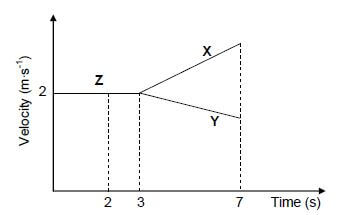
2.4 Write down the time at which the string breaks. (1)
2.5 Which portion (X, Y or Z) of the graph represents the motion of box Q, after the string breaks? Use the information in the graph to fully support the answer. (4) [17]
QUESTION 3 (Start on a new page.)
A ball is thrown vertically downwards from the top of a building and bounces a few times as it hits the ground. The velocity-time graph below describes the motion of the ball from the time it is thrown, up to a certain time T.
Take downwards as the positive direction and the ground as zero reference. The graph is NOT drawn to scale. The effects of air friction are ignored. 
3.1 Write down the speed with which the ball is thrown downwards. (1)
3.2 ALL parts of the graph have the same gradient. Give a reason for this. (2)
3.3 Calculate the:
3.3.1 Height from which the ball is thrown (3)
3.3.2 Time (T) shown on the graph (4)
3.4 Write down the:
3.4.1 Time that the ball is in contact with the ground at the first bounce (1)
3.4.2 Time at which the ball reaches its maximum height after the first bounce (2)
3.4.3 Value of X (1)
3.5 Is the collision of the ball with the ground elastic or inelastic? Give a reason for the answer using information in the graph. (2) [16]
QUESTION 4 (Start on a new page.)
The diagram below shows two skateboards, A and B, initially at rest, with a cat standing on skateboard A. The skateboards are in a straight line, one in front of the other and a short distance apart. The surface is flat, frictionless and horizontal. 
4.1 State the principle of conservation of linear momentum in words. (2)
EACH skateboard has a mass of 3,5 kg. The cat, of mass 2,6 kg, jumps from skateboard A with a horizontal velocity of 3 m∙s-1and lands on skateboard B with the same velocity of 3 m∙s-1.
Refer to the diagram below. 
4.2 Calculate the velocity of skateboard A just after the cat has jumped from it. (5)
Immediately after the cat has landed, the cat and skateboard B move horizontally to the right at 1,28 m∙s-1.
4.3 Calculate the magnitude of the impulse on skateboard B as a result of the cat's landing. (3) [10]
QUESTION 5 (Start on a new page.)
A slide, PQR, at an amusement park consists of a curved frictionless section, PQ, and a section, QR, which is rough, straight and inclined at 30oto the horizontal. The starting point, P, is 3 m above point Q. The straight section, QR, is 5 m long.
A learner, with mass 50 kg, starting from rest at P, slides down section PQ, then continues down the straight section, QR. 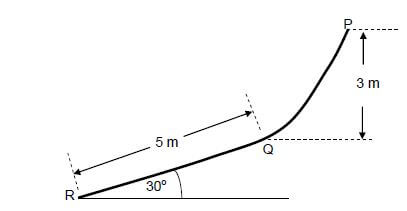
5.1 State the law of conservation of mechanical energy in words. (2) 5.2 Calculate the speed of the learner at Q. (4)
5.3 Draw a labelled free-body diagram for the learner while he/she is on section QR. (3)
The coefficient of kinetic friction (µk) between the learner and the surface of section QR is 0,08.
5.4 Calculate the magnitude of the kinetic frictional force acting on the learner when the learner is on section QR. (3)
5.5 Use energy principles to calculate the speed of the learner at point R. (5) [17]
QUESTION 6 (Start on a new page.)
A police car is moving at a constant speed on a straight horizontal road. The siren of the car emits sound of constant frequency. EACH of two observers, A and B, standing some distance apart on the same side of the road, records the frequency of the detected sound. Observer A records a frequency of 690 Hz and observer B records a frequency of 610 Hz. 
6.1 State the Doppler Effect in words. (2)
6.2 In which direction is the car moving? Choose from TOWARDS A or AWAY FROM A. Give a reason for the answer. (2)
6.3 Determine the speed of the police car. Take the speed of sound in air as 340 m.s-1. (6)
6.4 Name ONE application of the Doppler effect. (1) [11]
QUESTION 7 (Start on a new page.)
Two point charges, P and S, are placed a distance 0,1 m apart. The charge on P is +1,5 x 10-9 C and that on S is -2 x 10-9 C. A third point charge, R, with an unknown positive charge, is placed 0,2 m to the right of point charge S, as shown in the diagram below. 
7.1 State Coulomb's law in words. (2)
7.2 Draw a labelled force diagram showing the electrostatic forces acting on R due to P and S. (2)
7.3 Calculate the magnitude of the charge on R, if it experiences a net electrostatic force of 1,27 x 10-6 N to the left.
Take forces directed to the right as positive. (7) [11]
QUESTION 8 (Start on a new page.)
P is a point 0,5 m from charged sphere A. The electric field at P is 3 x 107 N∙C-1 directed towards A. Refer to the diagram below. 
8.1 Draw the electric field pattern due to charged sphere A. Indicate the sign of the charge on the sphere in your diagram. (2)
8.2 Calculate the magnitude of the charge on sphere A. (3)
Another charged sphere, B, having an excess of 105 electrons, is now placed at point P.
8.3 Calculate the electrostatic force experienced by sphere B. (6) [11]
QUESTION 9 (Start on a new page.)
9.1 The two graphs below show the relationship between current and potential difference for two different conductors, X and Y. 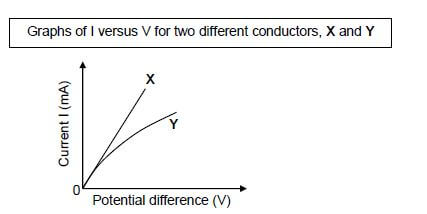
9.1.1 State Ohm's law in words. (2)
9.1.2 Which ONE of the two conductors, X or Y, is ohmic? Refer to the graph and give a reason for the answer. (2)
9.2 In the diagram below, a battery with an emf of 6 V and an internal resistance of 2 Ω, is connected to three resistors P, Q and R. A voltmeter V is connected across the battery. The ammeter A has a negligible resistance. 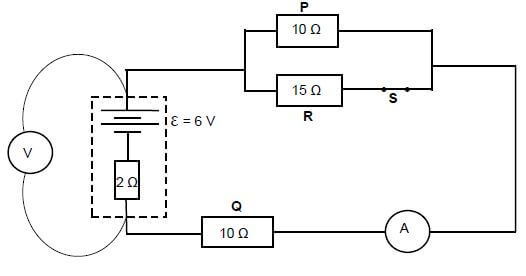
9.2.1 Calculate the ammeter reading when switch S is closed. (5)
The switch S is now open.
9.2.2 Will the ammeter reading in QUESTION 9.2.1 INCREASE, DECREASE or REMAIN THE SAME? Give a reason for the answer. (2)
9.2.3 How will the voltmeter reading now compare with the voltmeter reading when the switch is closed? Choose from INCREASE, DECREASE or REMAIN THE SAME. (1)
9.2.4 Explain the answer to QUESTION 9.2.3. (3) [15]
QUESTION 10 (Start on a new page.)
10.1 Learners want to build a small DC motor as a project. Write down THREE essential components that are needed for the building of the motor. (3)
10.2 An electrical device with a resistance of 11 Ω is connected to an AC source with an rms voltage of 240 V.
10.2.1 Define the term rms voltage. (2)
10.2.2 Calculate the maximum (peak) current passing through the device. (4) [9]
QUESTION 11 (Start on a new page.)
11.1 In the diagram below, monochromatic light is incident on the metal plate of a photocell. A sensitive ammeter shows a reading. 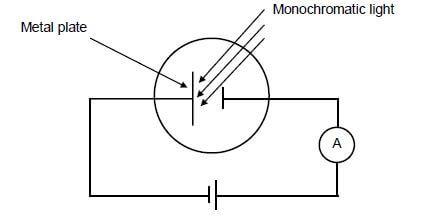
11.1.1 How does the energy of the photons of the incident light compare to the work function of the metal plate? Choose from GREATER THAN, LESS THAN or EQUAL TO. Give a reason for the answer. (2)
11.1.2 When a change is made to the monochromatic light, the reading on the ammeter increases. A learner makes the following statement with regard to this change: The increase in the ammeter reading is due to an increase in the energy of the incident photons. Give a reason why this statement is INCORRECT. (2)
11.1.3 What does the photoelectric effect tell us about the nature of light? (1)
11.2 Ultraviolet radiation is incident on the surface of sodium metal. The threshold frequency (f0) for sodium is 5,73 x 1014 Hz. The maximum speed of an electron emitted from the metal surface is 4,19 x105 m∙s-1.
11.2.1 Define or explain the term threshold frequency. (2) Calculate the:
11.2.2 Work function of sodium (3)
11.2.3 Frequency of the incident photon (3) [13]
TOTAL: 150
DATA FOR PHYSICAL SCIENCES GRADE 12
PAPER 1 (PHYSICS)
TABLE 1: PHYSICAL CONSTANTS
NAME | SYMBOL | VALUE |
Acceleration due to gravity | g | 9,8 m•s-2 |
Universal gravitational constant | G | 6,67 × 10-11 N•m2•kg-2 |
Speed of light in a vacuum | c | 3,0 × 108 m•s-1 |
Planck's constant | h | 6,63 × 10-34 J•s |
Coulomb's constant | k | 9,0 × 109 N•m2•C-2 |
Charge on electron | e | -1,6 × 10-19 C |
Electron mass | me | 9,11 × 10-31 kg |
Mass of earth | ME | 5,98 × 1024 kg |
Radius of earth | RE | 6,38 × 103 km |
TABLE 2: FORMULAE
MOTION
| vf = vi + aΔt | Δx = ViΔt + ½aΔt2 or Δy = ViΔt2 + ½aΔt2 |
Vf2 = Vi2 + 2aΔx or Vf2 = vi2 + 2aΔy | Δx = [Vi + Vf]Δt or Δy = [Vi + Vf]Δt |
FORCE
Fnet = ma | p= mv |
fsmax = µsN | fk = µkN |
FnetΔt = Δp | w =mg |
F = Gm1m2 | g = G M |
WORK, ENERGY AND POWER
W =FΔxcosθ | U= mgh or EP = mgh |
K = ½mv2 or Ek = ½mv2 | Wnet = ΔK or Wnet = ΔEk ΔK = Kf −Ki or ΔEk =Ekf − Eki |
Wnc= ΔK + ΔU or Wnc= ΔEk + ΔEp | P = W Δt |
Pav = Fv |
WAVES, SOUND AND LIGHT
v = f λ | T =1/f |
fl = v ± vl fs fl = v ± vl fb | E = hf or E = h c |
E = W0 + Ek where | |
ELECTROSTATICS
| F = kQ1Q2 r2 | E = KQ |
E = V | E = F |
V = W | n = Q |
ALTERNATING CURRENT
| Irms = 1max √ 2 Vrms = Vmax √2 | Pave = VrmsIrms Pave = 12rmsR Pave = V2rms R |
PHYSICAL SCIENCES: PHYSICS PAPER 1 GRADE 12 MEMORANDUM - NSC PAST PAPERS AND MEMOS FEBRUARY/MARCH 2018
PHYSICAL SCIENCES: PHYSICS
PAPER 1
GRADE 12
NSC PAST PAPERS AND MEMOS
FEBRUARY/MARCH 2018
MEMORANDUM
QUESTION 1
1.1 A✔✔ (2)
1.2 B✔✔ (2)
1.3 C✔✔ (2)
1.4 B✔✔ (2)
1.5 A✔✔ (2)
1.6 B✔✔ (2)
1.7 C✔✔ (2)
1.8 C✔✔ (2)
1.9 D✔✔ (2)
1.10 B✔✔ (2) [20]
QUESTION 2
2.1. A body will remain in its state of rest or motion at constant velocity unless a non-zero resultant/net force acts on it. ✔✔ (2)
2.2
Accepted labels | |
w | Fg / Fw/weight / mg / gravitation force |
T | FT/tension |
fk | (Kinetic) Friction / Ff / 4 N / f / wrywing / Fw |
N | FNormal / Normal / FN |
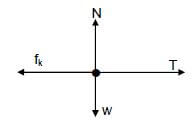 (4)
(4)
Notes
- Mark awarded for label and arrow
- Do not penalise for length of arrows since drawing is not to scale.
- Any other additional force(s) 3/4
- If force(s) do not make contact with body 3/4
2. 3 Object Q
- Fnet = ma
Fnet = 0
T + (fk) = ma
T - 3 ✔ = 0 ✔
T = 3 N
Object P
- Fnet = ma
Fhor - (fk +T) = ma✔
(Fcos 30o) - 5 - 3 = 0 ✔
F = 9,24 N✔ (9,238 N) (6)
2.4 3 s✔ (1)
2.5 Y✔
- Graph Y represents the motion of Q after the string breaks.
The graph Y shows a decreasing velocity ✔with a negative acceleration. ✔
This is because the net force (friction) acting on Q is in the opposite direction to its motion,✔ (accept: only frictional force acts on Q). (4) [17]
QUESTION 3
3.1 10 m∙s-1✔ (1)
3.2 The gradient represents the acceleration due to gravity (g) which is constant for free fall. ✔ [The graphs represent free fall] (1)
3.3.1 POSITIVE MARKING FROM QUESTION 3.1
| OPTION 1 | |
| Δy = viΔt + ½ aΔt2 ✔ = (10)(2) + ½ (9,8)( 22) ✔ = 39,6 m Height = 39,6 m ✔ | Δy = viΔt + ½ aΔt2✔ = (-10)(2) + ½ (-9,8)( 22)✔ = -39,6 m Height = 39,6 m ✔ |
OPTION 2 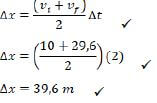 | OPTION 3 |
| OPTION 4 Height = Area under the graph or [Any one ✔] =Area of + Area of = (10)(2)+(½)(2)(19,6) ✔ = 39,6 m ✔ | |
OPTION 5 | |
3.3.2
| OPTION 1 vf = vi + aΔt✔ 0 = -25 + (9,8)( Δt ) ✔ Δt = 2,55 s Total time T = 8 +2,55 ✔ = 10,55 s✔ | OPTION 2 |
OPTION 3 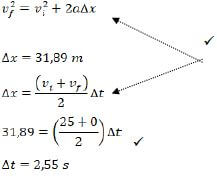 Total time T = 8 +2,55 ✔ = 10,55 s✔ | OPTION 4 Total time T = 8 +2,55 ✔ = 10,55 s ✔ |
| OPTION 5 Slope of graph = 9,8 = 0 - (-25) T - 8 Total time T = 8 +2,55 ✔ = 10,55 s✔ | If values of vi and vf are swopped around,and a negative time is obtained, give 1 mark for formula and 1 mark for adding calculated time to 8 s, (max 2/4). |
3.4.1 0,2 s✔ (1)
3.4.2 4,955 s✔✔ (2)
3.4.3 - 27 (m.s-1) ✔ [Must include the negative] (1)
3.5 Inelastic.✔
- The speeds at which it strikes and leaves the ground are not the same/The kinetic energies will not be the same ✔ (2) [16]
QUESTION 4
4.1
- The total linear momentum of a closed (isolated) system remains constant (is conserved). ✔✔
OR - In an isolated system, the total linear momentum before collision is equal to the total linear momentum after collision ✔✔
(If key words isolated and total missing -1 mark for each.) (2)
4.2
- Formulae either
- ∑p = ∑pf
OR - m1v1i + m2v2i = m1v1f + m2v2f
Any one
- ∑p = ∑pf
- For the system cat-skate board A
(3,5)(0) + (2,6)(0) ✔ = (3,5)vskateboard + (2,6)(3) ✔
Vskateboard = 2,23 m∙s-1✔ to the left✔
ACCEPT v = -2,23 m∙s-1✔✔ (5)
4.3 Fnet Δt = Δp = mvf - mvi✔
- = (3,5)(1,28 - 0) ✔
= 4,48 N∙s (4,48 kg∙ms-1)✔
OR
Fnet Δt = Δp = mvf - mvi✔
- = (2,6)(1,28 - 3) ✔
= -4,48 N∙s (4,48 kg∙ms-1)
∴ Δp = 4,48 N.s✔ (3) [10]
QUESTION 5
5.1 The total mechanical energy/sum of kinetic and gravitational potential energy in a closed/isolated system is constant (conserved).✔✔
(If key words isolated and total missing -1 mark for each.) (2)
5.2
- E MECH P = E MECH Q
(EP + EK)P = (EP + E K )Q
✔1 mark for any of the three
Wnet = ΔEk
Wcon = ΔEk - (mgh + 1/2 mv2)P = (mgh + 1/2 mv2)Q
50 (9,8)(3) + 0 ✔= 0 + ½ (50)v2✔
v = 7,67 m∙s-1 ✔ (7,668 m∙s-1 ) (4)
5.3
| Accepted labels | ||
| w | Fg / Fw / weight / mg / gravitational force | ✔ |
| N | FN | ✔ |
| fk | Ff/friction/f | ✔ |
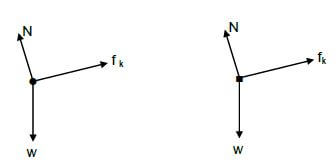 (3)
(3)
Notes
- Mark awarded for label and arrow
- Do not penalise for length of arrows since drawing is not to scale.
- Any other additional force(s) Max/Maks 2/3
- If force(s) do not make contact with body: Max/Maks: 2/3
5.4
- fk = μkN
= µk (mgcosθ) ✔ Any one/Enige een
= 0,08 (50 x 9,8) cos 30o✔
= 33,95 (33, 948) N ✔ (3)
NOTE: IN ALL THE OPTIONS FOR QUESTION 5.5 BELOW, ACCEPT THE SUBSTITUTION:
5 cos 60o IN PLACE OF/IN PLAAS VAN 5 sin 30o
5.5 OPTION 1
POSITIVE MARKING FROM QUESTION 5.4
- W = Fnet∆x cosθ
Wnet = Wf + Ww + WN
Wnet = Wf + (-∆ EP) + WN
Wnet = fk ∆x cos180 o + mgsinθ ∆xcos0 + 0 Wnet = ∆ EK/∆ K
Wnet = [33,948)(5)(-1)] + [(50)(9,8) (5)sin 30 o + 0]✔
= 1055, 26 (1055,259)
1055,259 = ½ (50) (vf 2 - 7,6682) ✔
vf = 10,05 m∙s-1✔
OPTION 2
POSITIVE MARKING FROM QUESTION 5.2
- Wnc = ΔEp + ΔEk
fΔxcosθ = (mghf - mghi) + ( ½ mvf2 - ½ mvi2)
1 mark for any of the two/
μmg∆x cos180 o = [ 0 - (mg∆x sin 30 o ] + ½ m(vf2 - vi2)
[33,948)(5)(-1)] = [0 - 50(9,8) (5) sin 30 o ]✔+ ½ (50) (vf 2 - 7,6682 )✔
vf = 10,05 m∙s-1✔
OPTION 3
POSITIVE MARKING FROM QUESTION 5.2 AND 5.4
- Wnc = ΔEp + ΔEk
f Δxcosθ = (mghf - mghi) + ( ½ mvf2 - ½ mvi2)
1 mark for any of the two
(33,95)(5) cos 180 ✔= [(50)(9,8) {0 - 5 sin30o}]✔ + ½ (50)( vf2 - 7,6682) ✔
vf = 10,05 m∙s-1✔ (5) [17]
QUESTION 6
6.1 An (apparent) change in the observed frequency (pitch), (wavelength) ✔as a result of the relative motion between a source and an observer ✔(listener). (2)
6.2 Towards A.✔
- Recorded frequency higher.✔ (2)
6.3
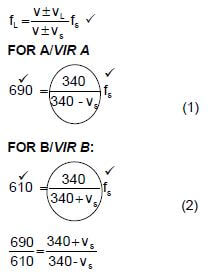
1,131 (340 - vs) = 340 + vs
vs = 20,90 m.s-1✔ (20.90 to 20.92 m.s-1) (6)
6.4 ANY ONE
- Doppler flow meter ✔
- Measuring foetal heartbeat
- Measure speed of blood flow
- Ultra sound
- Sonar
- Radar (for speeding) (1) [11]
QUESTION 7
7.1 The magnitude of the electrostatic force exerted by one point charge on another point charge is directly proportional to the product (of the magnitudes) of the charges and inversely proportional to the square of the distance between them. ✔✔ (2)
7.2![]()
NOTE:
- One mark for each force, correctly shown.
7.3 Taking right as positive
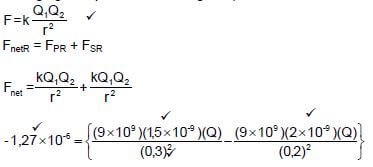
-1.27 x 10-6 = 150Q - 450Q (for subtraction)
Q = 4,23 x 10-9 C✔ (7)
Accept answers where left is taken as positive. [11]
QUESTION 8
8.1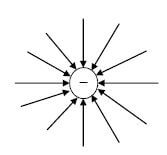
- Shape (radial) ✔
- Polarity (sign) of A✔
- Do not penalize for incorrect direction✔
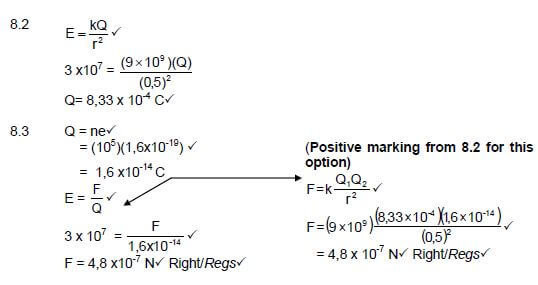 (3) , (6) [11]
(3) , (6) [11]
QUESTION 9
9.1.1
- The potential difference across a conductor is directly proportional to the current in the conductor at constant temperature.✔✔.
OR - The current in a conductor is directly proportional to the potential difference across the conductor at constant temperature. ✔✔ (2)
9.1.2 Graph X✔
- Graph X is a straight line (passing through the origin) therefore potential difference is directly proportional to current. ✔(2)
9.2.1
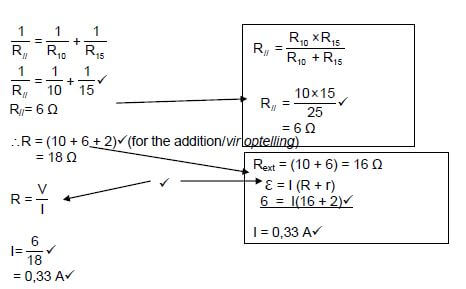 (5)
(5)
9.2.2 Decrease. ✔
- The total resistance of the circuit increases✔ (2)
9.2.3 Increase ✔ (1)
9.2.4
- The total resistance in the external circuit increases.✔
- Current decreases ✔
- ''Lost'' volts decreases ✔
OR - The total resistance in the external circuit increases.✔
- V α R for constant ✔
- Therefore V increases. (3) [15]
QUESTION 10
10.1 ANY THREE
- Permanent magnets
- coils (armature)
- commutator
- brushes
- power supply/battery (3)
10.2.1 The rms voltage of AC is the potential difference which dissipates the same amount of energy as the equivalent DC potential difference. ✔✔
Accept formula for Vrms as 1 mark. (2)
10.2.2 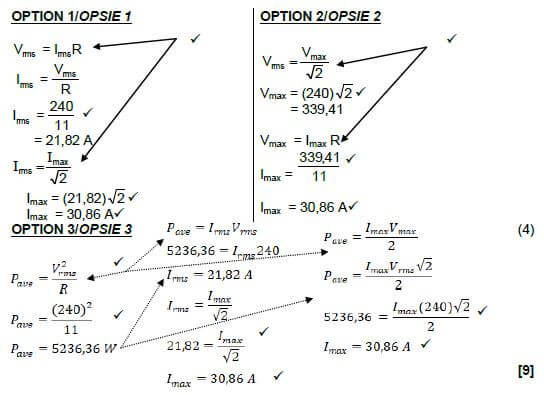
QUESTION 11
11.1.1 Greater than ✔
- Electrons are ejected from the metal plate ✔ Accept: a current is registered on the ammeter. (2)
11.1.2
- Increase in intensity means that (for the same frequency) the number of photons per second increases (ammeter reading increases)✔but the energy of the photons stays the same ✔(Therefore the statement is incorrect).
OR - An increase in the energy of the photons only increases the kinetic energy of the photoelectrons and not the number of photoelectrons, thus the ammeter reading will not change. (2)
11.1.3 Light has a particle nature. Accept light energy is quantized ✔ (1)
11.2.1The minimum frequency needed for the emission of electrons (from a metal surface). (2)
11.2.2
- W0 = hf0 ✔
= (6,63 x 10-34)(5,73 x 1014)✔
= 3,8 x 10-19J✔ [3,799 x 10-19 J] (3)
11.2.3 POSITIVE MARKING FROM QUESTION 11.2.2
OPTION 1
- E = W0 + Ek(max)
hf = hf0 + Ek(max)
hf = hf0 + ½ mv2
E = W0 + ½ mv2
✔ Any one - (6,63 x 10-34)f = 3,8 x 10-19 + [½(9,11 x 10-31)(4,19 x 105)2]✔
f = 6,94 x 1014 Hz✔ [7 x 1014 Hz]
OPTION 2
- E = W0 + Ek(max)
hf = hf0 + Ek(max)
hf = hf0 + ½ mv2
E = W0 + ½ mv2
✔ Any one - E = 3,8 x 10-19 + [½(9,11 x 10-31)(4,19 x 105)2]✔ hf = 4,599 x 10-19
(6,63 x 10-34)f = 4,599 x 10-19
f = 6,94 x 1014 Hz✔ [7 x 1014 Hz] (3) [13]
TOTAL: 150
MECHANICAL TECHNOLOGY GRADE 12 QUESTIONS - NSC PAST PAPERS AND MEMOS FEBRUARY/MARCH 2018
MECHANICAL TECHNOLOGY
GRADE 12
NSC PAST PAPERS AND MEMOS
FEBRUARY/MARCH 2018
INSTRUCTIONS AND INFORMATION
- This question paper consists of TEN questions.
- Read ALL the questions carefully.
- Answer ALL the questions.
- Number the answers correctly according to the numbering system used in this question paper.
- Start EACH question on a NEW page.
- Show ALL calculations and units. Round off ALL answers to TWO decimal places.
- Candidates may use non-programmable, scientific calculators and drawing instruments.
- Take the value of gravitational force as 10 m/s-2.
- All dimensions are in millimetres, unless stated otherwise in the question.
- A formula sheet for your use is attached to this question paper.
- Write neatly and legibly.
- Use the guidelines below to assist you in managing your time.
QUESTION | CONTENT | MARKS | TIME (minutes) |
1 | Multiple-choice questions | 20 | 15 |
2 | Safety | 10 | 10 |
3 | Tools and Equipment | 12 | 10 |
4 | Materials | 13 | 10 |
5 | Terminology | 30 | 20 |
6 | Joining Methods | 25 | 25 |
7 | Forces | 30 | 30 |
8 | Maintenance | 15 | 15 |
9 | Systems and Control | 25 | 25 |
10 | Turbines | 20 | 20 |
TOTAL | 200 | 180 | |
QUESTIONS
QUESTION 1: MULTIPLE-CHOICE QUESTIONS
Various options are provided as possible answers to the following questions. Choose the answer and write only the letter (A–D) next to the question number (1.1–1.20) in the ANSWER BOOK, for example 1.21 D.
1.1 FIGURE 1.1 shows one of the steps to remove and replace bearings. Which safety procedure is indicated in FIGURE 1.1?
FIGURE 1.1
- Remove the dolly by tapping it with a hammer.
- Remove the burrs from the shaft to prevent damage to the dolly.
- Place the driving dolly against the inner ring of the bearing and tap the dolly with a hammer.
- Slacken the lock nut by tapping it lightly with a hammer. (1)
1.2 Which ONE of the following safety procedures applies to the maintenance of a hydraulic press?
- Do not apply a wrench to a revolving part.
- Guards could be removed when pressing soft material.
- Pressure gauges must be tested regularly and adjusted or replaced if any malfunction occurs.
- Use the machine table as an anvil. (1)
1.3 The function of a valve-spring tester is to test the valve spring for … and squareness before fitting.
- twisting
- tension
- shearing
- deflection (1)
1.4 What is the function of a depth micrometer?
- Measures the outside diameter of a workpiece accurately
- Measures the inside diameter of a hole in a work piece accurately
- Measures the pitch diameter of a screw thread accurately
- Measures the depth of a hole in a workpiece accurately (1)
1.5 Which structure of steel is characterised as intensely hard and brittle?
- Ferrite
- Pearlite
- Cementite
- Austenite (1)
1.6 Which ONE of the following mechanical properties of steel represents resistance to shock loads?
- Brittleness
- Toughness
- Hardness
- Elasticity (1)
1.7 What is the included angle of a metric V-screw thread?
- 60°
- 45°
- 55°
- 29° (1)
1.8 What is a disadvantage of down-cut milling?
- The cutter blunts rapidly when it is used to cut material with surface scale on it.
- It can cut through thin pipes and tubes.
- A better finish is produced.
- The coolant is carried down to the teeth where it is required. (1)
1.9 Which ONE of the following tests uses sound waves to penetrate a test piece?
- Ultrasonic test
- X-ray test
- Dye penetration test
- Nick-break test (1)
1.10 Which ONE of the following is the cause of undercutting during the welding process?
- Rapid chilling
- Current too high
- Slag not removed from the previous run weld
- Dirty or wet weld electrode (1)
1.11 Which ONE of the following statements defines strain in a material? Strain is the ratio between the …
- change in length and the original length.
- change in diameter and the original length.
- total length and the original length.
- change in stress and the original stress. (1)
1.12 Refer to FIGURE 1.12 below. What type of stress, caused by force F, will occur in the bolt of the joint? 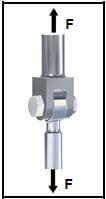
FIGURE 1.12
- Tensile stress
- Compressive stress
- Shearing stress
- Compression stress (1)
1.13 What is the unit measure for moments?
- N/m
- N.m
- N.m2
- N.m-2(1)
1.14 What is understood by the term viscosity regarding liquids? It is the resistance to …
- flow.
- boiling.
- cooling.
- foaming. (1)
1.15 Where will you use EP 90 oil?
- Engines
- Power steering
- Brakes
- Gearbox (1)
1.16 FIGURE 1.16 below represents a hydraulic system. What is the comparison between the fluid pressure at piston A and the fluid pressure at piston B? 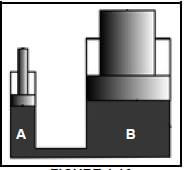
FIGURE 1.16
- The pressure at piston A is the same as the pressure at piston B.
- The pressure at piston A is more than the pressure at piston B.
- The pressure at piston A is less than the pressure at piston B.
- The pressure at piston A is double the pressure at piston B. (1)
1.17 Which ONE of the following statements defines Boyle's law?
- An ideal gas law where, at constant pressure, the volume of an ideal gas is inversely proportional to its absolute temperature.
- An ideal gas law where, at constant volume, the temperature of an ideal gas is inversely proportional to its absolute pressure.
- An ideal gas law where, at constant temperature, the volume of an ideal gas is inversely proportional to its absolute pressure.
- An ideal gas law where, at constant temperature, the volume of an ideal gas is proportional to its absolute pressure. (1)
1.18 What will the velocity ratio of a belt drive system be if the driven pulley rotates at 1 000 r/min and the driver pulley at 100 r/min?
- 1 : 10
- 10 : 1
- 1 : 100
- 100 : 1 (1)
1.19 A steam turbine is used to …
- increase the fuel consumption in relation to engine output.
- drive a generator to generate electricity.
- increase the volumetric efficiency of an engine.
- increase atmospheric pressure in an engine. (1)
1.20 The advantage of a turbocharger compared to a supercharger is that it uses … to drive it.
- exhaust gases
- power from the engine
- a belt
- a fuel/air mixture (1) [20]
QUESTION 2: SAFETY
2.1 When assembling a cylinder head of a motor vehicle's engine, the valve springs must be tested before installation. State TWO safety precautions you should observe when working with the spring tester. (2)
2.2 Why is it important to wear an arc welding helmet during arc welding? (1)
2.3 Why is it important to keep the copper electrodes of a spot welder cool during operation? (1)
2.4 Name ONE distinct safety precaution when using EACH of the following items of testing equipment:
2.4.1 Brinell hardness tester (1)
2.4.2 Tensile tester (1)
2.4.3 Torsion tester (1)
2.5 At what angle to the bearing should a bearing puller be used? (1)
2.6 The following safety measures apply when using a cylinder leakage tester. Name ONE reason why you have to adhere to the following safety measures:
2.6.1 Do not exceed the prescribed pressure in the cylinder. (1)
2.6.2 The tester should be fitted properly in the spark plug hole or injector hole. (1) [10]
QUESTION 3: TOOLS AND EQUIPMENT
3.1 Tools and equipment are very important to complete different tasks in the workplace. Explain the function of EACH of the following testing equipment:
3.1.1 Cylinder compression tester (2)
3.1.2 Fuel pressure tester (2)
3.1.3 Torsion tester (2)
3.2 The gas analyser is used to determine the CO and CO2 readings of the exhaust gases of an internal combustion engine. Give TWO reasons for a high CO2 reading. (2)
3.3 Most welding companies use MIG/MAGS welding equipment for their welding.
3.3.1 Give TWO reasons for using inert gas during MIG/MAGS welding. (2)
3.3.2 State TWO advantages of the use of MIG/MAGS welding rather than arc welding. (2) [12]
QUESTION 4: MATERIALS
4.1 Temperature affects the structure of steel with regard to the iron-carbon content. State TWO characteristics of each of the following:
4.1.1 Austenite (2)
4.1.2 Ferrite (2)
4.2 Explain what happens at the following critical points in the iron-carbon equilibrium diagram:
4.2.1 Lower critical point (AC1) (2)
4.2.2 Higher critical point (AC3) (2)
4.3 Give TWO reasons for enhancing the properties of the material used for a crankshaft. (2)
4.4 Give TWO reasons for tempering a camshaft. (2)
4.5 Which heat treatment process is used on piston rings? (1) [13]
QUESTION 5: TERMINOLOGY
5.1 A parallel key must be machined to fit onto a 120 mm diameter shaft. Calculate the following:
5.1.1 The width of the key (2)
5.1.2 The thickness of the key (2)
5.1.3 The length of the key (2)
5.2 A spur gear with 124 teeth must be cut on a universal milling machine. Calculate the simple indexing to cut this gear with the help of a Cincinnati dividing head. (3)
5.3 The pitch of a metric V-screw thread is 3 mm. Calculate the height of the thread. (2)
5.4 A spur gear has 48 teeth and a module of 3. Calculate the following:
5.4.1 Addendum (1)
5.4.2 Dedendum (2)
5.4.3 Clearance (2)
5.4.4 Pitch circle diameter (2)
5.4.5 Outside diameter (2)
5.4.6 Cutting depth (2)
5.4.7 Circular pitch (2)
5.5 A metric V-screw thread needs to be cut on a centre lathe by setting the compound slide to half the included angle of the thread. The workpiece has been turned down to the required diameter and prepared to the necessary requirements. State the required settings to the lathe and cutting tool to enable you to cut the screw thread. (6) [30]
QUESTION 6: JOINING METHODS
6.1 Name TWO causes of EACH of the following welding defects:
6.1.1 Slag inclusion (2)
6.1.2 Incomplete penetration (2)
6.2 Name TWO causes of atmospheric contamination during MIG/MAGS welding. (2)
6.3 Explain the procedure to perform a nick-break test on a welded joint. (5)
6.4 Give ONE reason for performing the following destructive tests:
6.4.1 Bend test (2)
6.4.2 Machinability test (2)
6.5 Give ONE reason of conducting an X-ray test on a welding joint. (2)
6.6 Define the term weld crater. (2)
6.7 Study FIGURE 6.7 below.
FIGURE 6.7
6.7.1 Identify the welding process in FIGURE 6.7. (1)
6.7.2 Label parts A–E in FIGURE 6.7. (5) [25]
QUESTION 7: FORCES
7.1 Four forces are acting on the same point. Determine, by means of calculations, the magnitude and direction of the resultant force for the system of forces in FIGURE 7.1 below. (13)
FIGURE 7.1
7.2 A compressive force of 20 kN is applied to a mild steel bush. The outer diameter is 56 mm and the inner diameter is 38 mm. The original length of the bush was 50 mm. Calculate:
7.2.1 The resistance area of the bush (2)
7.2.2 The stress in the material (3)
7.2.3 The strain if the final length of the bush is 49,975 mm (3)
7.2.4 Young's modulus of elasticity for the material (3)
7.3 FIGURE 7.3 below shows a uniform beam, which is 6 m long, that is supported by two vertical supports, A and B. A uniformly distributed force of 100 N/m is exerted on the left-hand side of the beam between the two point loads of 600 N and 850 N. Determine, by means of calculations, the magnitudes of the reactions in supports A and B. 
FIGURE 7.3 (6) [30]
QUESTION 8: MAINTENANCE
8.1 What is the reason for using SAE20W50 viscosity oil or other multigrade oil in an internal combustion engine? (2)
8.2 State TWO procedures to maintain V-belt drive systems. (2)
8.3 Define the term flashpoint of a lubricant. (3)
8.4 State TWO aspects to adhere to when taking care of cutting fluid used on a lathe. (2)
8.5 State TWO functions of the clutch plate. (2)
8.6 Give TWO reasons for skimming the flywheel before installing a new clutch plate. (2)
8.7 Give TWO properties of grease. (2) [15]
QUESTION 9: SYSTEMS AND CONTROL
9.1 FIGURE 9.1 below shows a gear-drive system. Driver gear A on the shaft of the electric motor has 20 teeth that mesh with gear B with 36 teeth on a counter shaft. On the counter shaft is another driver gear, C, with 18 teeth that mesh with gear D with 46 teeth. The second counter shaft has driver gear E with 42 teeth, which drives gear F with 80 teeth on the output shaft. 
FIGURE 9.1
Calculate the:
9.1.1 Rotation frequency of the input shaft on the electric motor if the output shaft rotates at 160 r/min (3)
9.1.2 Velocity ratio between the input and output shaft (2)
9.2 FIGURE 9.2 below shows a belt drive system. The pulley, with a diameter of 0,24 m, drives the driven pulley with a diameter of 0,36 m. The driven pulley rotates at 733,33 r/min. T1 = 360 N and T2 = 90 N. 
FIGURE 9.2
Calculate the:
9.2.1 Rotation frequency of the driver pulley in r/min (revolutions per minute) (3)
9.2.2 Power transmitted (2) 9.2.3 Belt speed of the system in m.s-1(metres per second) (2)
9.3 A hydraulic system is used to lift a machine. The specifications of the system are presented diagrammatically in FIGURE 9.3 below. 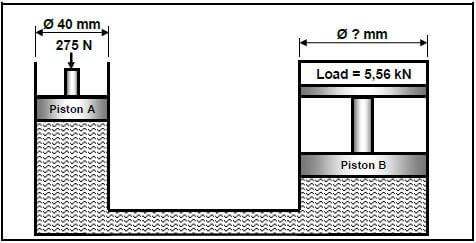
FIGURE 9.3
Calculate the:
9.3.1 Fluid pressure in the hydraulic system when in equilibrium (5)
9.3.2 Diameter of piston B to lift a load of 5,56 kN (4)
9.4 What is the purpose of the anti-lock brake system (ABS) in a vehicle? (2)
9.5 What does the abbreviation ECU stand for in terms of motor vehicles? (1)
9.6 State ONE advantage of a traction control system in a motor vehicle. (1) [25]
QUESTION 10: TURBINES
10.1 Name TWO types of reaction turbines. (2)
10.2 Explain the term boost in terms of superchargers. (2)
10.3 Name TWO types of blowers used as superchargers on a motor vehicle's engine. (2)
10.4 A gas turbine that is used as a jet engine is shown in FIGURE 10.4. Label A–F. 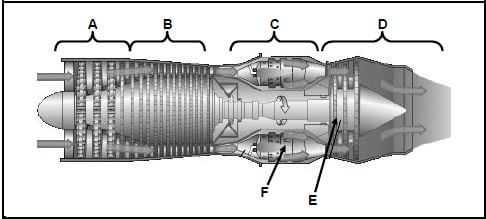
FIGURE 10.4 (6)
10.5 State TWO applications of a gas turbine. (2)
10.6 State TWO advantages of a gas turbine. (2)
10.7 What is the purpose of the waste gate in a turbocharger? (2)
10.8 Why is an engine with a turbocharger fitted with an oil cooler? (2) [20]
TOTAL: 200
FORMULA SHEET 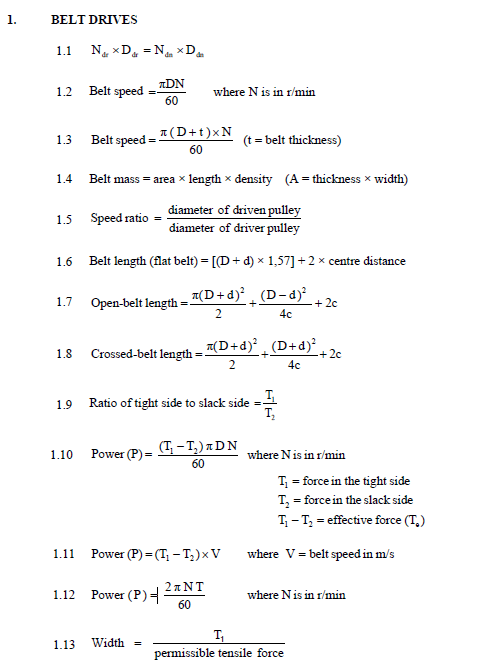
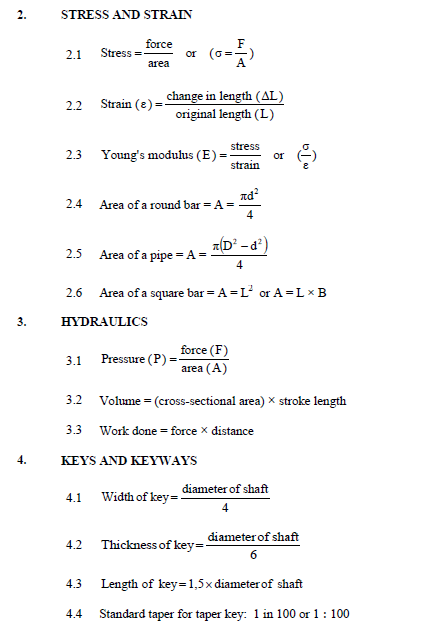
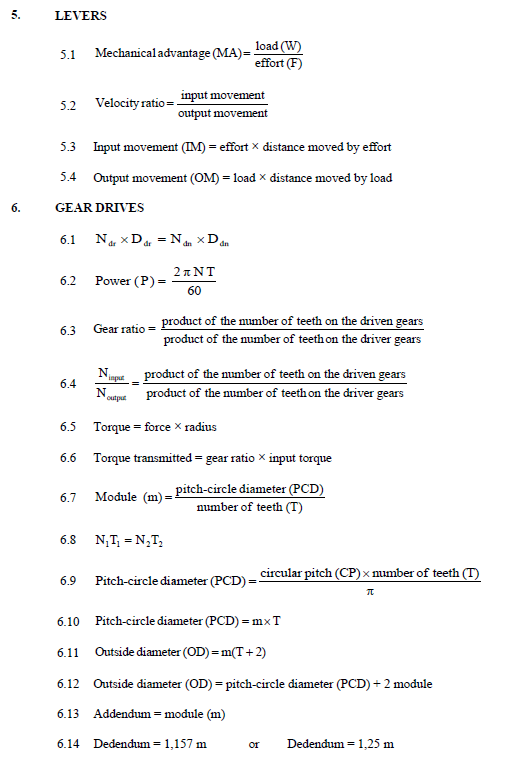
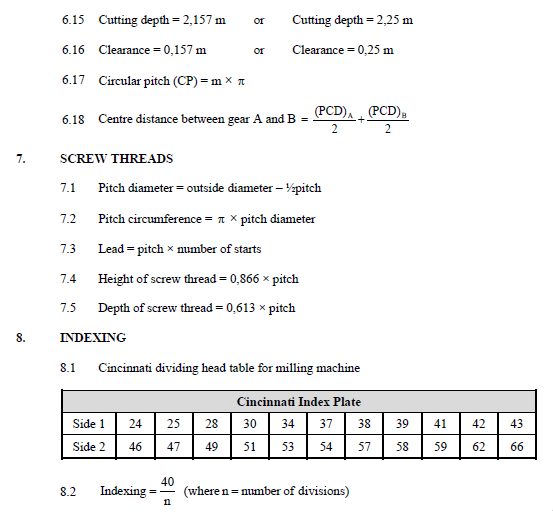
MECHANICAL TECHNOLOGY GRADE 12 MEMORANDUM - NSC PAST PAPERS AND MEMOS FEBRUARY/MARCH 2018
MECHANICAL TECHNOLOGY
GRADE 12
NSC PAST PAPERS AND MEMOS
FEBRUARY/MARCH 2018
MEMORANDUM
QUESTION 1: MULTIPLE-CHOICE QUESTIONS
1.1 C ✔ (1)
1.2 C ✔ (1)
1.3 B ✔ (1)
1.4 D ✔ (1)
1.5 C ✔ (1)
1.6 D ✔ (1)
1.7 A ✔ (1)
1.8 A ✔ (1)
1.9 A ✔ (1)
1.10 B ✔ (1)
1.11 A ✔ (1)
1.12 C ✔ (1)
1.13 B ✔ (1)
1.14 A ✔ (1)
1.15 D ✔ (1)
1.16 A ✔ (1)
1.17 C ✔ (1)
1.18 A ✔ (1)
1.19 B ✔ (1)
1.20 A ✔ (1) [20]
QUESTION 2: SAFETY
2.1 Spring tester
- Use correct attachments of the valve spring tester to compress the spring. ✔
- Do not exceed the prescribed pressure. ✔
- Ensure that the spring does not slip out. ✔
(ANY 2 x 1) (2)
2.2 Welding helmet
- To protect your eyes against the dangerous ultra-violet rays. ✔
- To protect your skin against the dangerous ultra-violet rays. ✔
- To protect your eyes against the sparks. ✔
- To protect your skin against the sparks. ✔
(ANY 1 x 1) (1)
2.3 Spot welding
- To prevent the electrodes from overheating. ✔ (1)
2.4 Testers
2.4.1 Brinell tester
- The tester must be mounted on the rigid spot on a workbench ✔
- The force must be applied at an angle of 90° to the test piece ✔
- Do not exceed the prescribed load ✔
- Make sure the test piece is placed securely into position ✔
(ANY 1 x 1) (1)
2.4.2 Tensile tester
- Make sure all safety guards are in place ✔
- Do not exceed the prescribed load ✔
- See that the test piece is securely placed in position ✔
- Make sure the dial indicator is mounted properly ✔
(ANY 1 x 1) (1)
2.4.3 Torsion tester
- Fasten the tester to the workbench ✔
- When you add pieces of different mass, you should attach them very gently otherwise you could get a skew reading of the torsion on the rod ✔
- Get specification (torsion) of the different materials and of the size rods you would like test ✔
(ANY 1 x 1) (1)
2.5 Bearing puller
- Perpendicular or 90° to the bearing. ✔ (1)
2.6 Cylinder leakage tester
2.6.1
- To prevent damage to the seals and tester ✔
- To ensure the correct reading ✔
(ANY 1 x 1) (1)
2.6.2
- To prevent damage to the tester and spark plug hole or injector hole ✔
- To ensure the correct reading ✔
(ANY 1 x 1) (1) [10]
QUESTION 3: TOOLS AND EQUIPMENT
3.1 Testers
3.1.1 Cylinder leakage tester
- Is used to determine a leakage in the cylinder✔.
- Determine the volume of leakage✔ (2)
3.1.2 Fuel pressure tester
- Is used to test the fuel operating pressure in the system ✔
- Is used to test the fuel pressure in the fuel line that runs to the direct injection. ✔ (2)
3.1.3 Torsion tester
- Is used to investigate the relationship between momentum or torque applied to material ✔
- Is used to investigate influence of material length on torsional deflection. ✔ (2)
3.2 Reasons for high CO2 reading
- Lean fuel mixture setting ✔
- Low compression ✔
- Faulty high tension leads ✔
(ANY 2 x 1) (2)
3.3 MIGS/MAGS-welding
3.3.1 Reasons for using inert gas during MIGS/MAGS welding
- Stabilises the arc on the parent metal ✔
- Shields the arc and weld pool from atmospheric gases like oxygen ✔ (2)
3.3.2 Advantages of MIGS/MAGS welding
- Can weld in any position ✔
- Less operator skill required ✔
- Continuous welding can be done ✔
- Causes less deformation ✔
- Faster than arc welding ✔
- Minimal post weld cleaning ✔
- No slag removal is required ✔
(ANY 2 x 1) (2) [12]
QUESTION 4: MATERIALS
4.1 Characteristics of structures
4.1.1 Austenite
- Soft ✔
- Coarse grain structure ✔
- Non-magnetic ✔
(ANY 2 x 1) (2)
4.1.2 Ferrite
- Soft ✔
- Ductile ✔
- Magnetic ✔
(ANY 2 x 1) (2)
4.2 Iron-carbon equilibrium diagram
4.2.1 Lower critical point (AC1) of steel
- The structure starts to change ✔✔ (2)
4.2.2 Higher critical point (AC3) of steel
- The structure turns into complete Austenite ✔✔
- The steel completely loses its magnetic properties ✔✔
- The structure turns into its finest grain size ✔✔
(ANY 1 x 2) (2)
4.3 Reasons to enhance properties of a crankshaft
- To produce a hard face with a tough core. ✔
- To induce toughness ✔ (2)
4.4 Reasons for the tempering of a camshaft
- To increase the lifespan of the camshaft ✔
- To eliminate brittleness caused by hardening. ✔
(ANY 2 x 1) (2)
4.5 Heat treatment process on piston rings
- Hardening ✔ (1) [13]
QUESTION 5: TERMONOLOGY
5.1 Key dimensions
5.1.1 The width of the key
- Width = D
4
= 120 ✔
4
= 30 mm ✔ (2)
5.1.2 The thickness of the key
- Thickness = D
6
= 120 ✔
6
= 20 mm ✔ (2)
5.1.3 The length of the key
- Length = D × 15 ✔
= 120 × 15 ✔
= 180 mm (2)
5.2 Indexing
- Indexing = 40
n
= 40 ÷ 2 ✔
124 2
= 20 ✔
62
No full turns and 20 holes in a 62 hole circle (3)
5.3 Height of screw the screw thread
- H = 0 866
= 3 × 0 866 ✔
= 2 6 mm ✔ (2)
5.4 Gear terminology
5.4.1 Addendum = m
- = 3 mm ✔ (1)
5.4.2 Dedendum
- = 1,157 m or =1,25 m
= 1,157 x 3 ✔ =1,25 x 3 ✔
= 3,47 mm ✔ =3,75 mm ✔ (2)
5.4.3 Clearance
- = 0,157 m or =0,25m
= 0,157 x 3 ✔ =0,25 x 3 ✔
= 0,47 mm ✔ =0,75 mm ✔ (2)
5.4.4
- Module = PCD
T
PCD = m × T ✔
= 3 × 48 ✔
= 144 mm ✔(2)
5.4.5
- OD = PCD + 2m ✔
= 144 + 2(3)
= 144 + 6
= 150 mm ✔ (2)
5.4.6 Cutting depth
- = 2,157 m ✔ or =2,25m ✔
= 2,157 x 3 =2,25 x 3
= 6,47 mm ✔ =6,75 mm ✔ (2)
5.4.7 Circular pitch
- = m x π✔
= 3 x π
= 9,42 mm ✔ (2)
5.5 Setting of the lathe and cutting tool to cut a metric V-screw thread:
- Set the lathe to the correct speed for screw cutting ✔
- Set the lead screw according to the required pitch ✔
- Set the dial gauge to position with the required worm gear ✔
- Set the compound slide to half the included angle of the thread (30°) ✔
- Set the cutting tool centre height and 90° to the work piece with the help of a centre gauge ✔
- Set cross slide and compound slide collars to zero with the tool touching the work piece ✔ (6) [30]
QUESTION 6: JOINING METHODS
6.1 Welding defects
6.1.1 Slag inclusion
- Welding speed too fast ✔
- Not removing the slag from the previous weld run before welding the next run ✔
- Current too low ✔
(ANY 2 x 1) (2)
6.1.2 Incomplete penetrations
- Welding speed too fast ✔
- Faulty joint design ✔
- Electrode too large ✔
- Current too low ✔
(ANY 2 x 1) (2)
6.2 Atmospheric contamination during MIGS/MAGS welding
- Inadequate shielding gas flow ✔
- Excessive shielding gas flow ✔
- Severely clogged nozzle ✔
- Damaged gas supply system ✔
- Excessive wind in the welding area ✔
(ANY 2 x 1) (2)
6.3 Nick break test
- Make a hacksaw cut at both edges, through the centre of the weld ✔
- Place the saw-nicked specimen on two steel supports ✔
- Use a sledge hammer to break the specimen by striking it in the zone where you made the saw cuts ✔
- Defects like incomplete fusion, slag inclusion and brittleness will be exposed in the break ✔
- Any defects bring it to the attention to the welder to rectify it ✔ (5)
6.4 Reasons for destructive tests
6.4.1 Bend test
- To determine the ductility/elongation ✔✔ of the weld metal. (2)
6.4.2 Machinability test
- To determine the welds hardness ✔ and its strength. ✔ (2)
6.5 X-ray test
- To detect internal defects in the weld metal✔✔ (2)
6.6 Weld crater
- Forms where welding is resumed at the bottom of the previous weld instead of on the top ✔✔ (2)
6.7 MIGS/MAGS welding
6.7.1 Welding process
- MIGS/MAGS welding ✔ (1)
6.7.2 Labelling
- A. Parent metal ✔
- B. Arc ✔
- C. Electrode wire ✔
- D. Gas shroud ✔
- E. Shielding gas ✔ (5) [25]
QUESTION 7: FORCES
7.1 Resultant 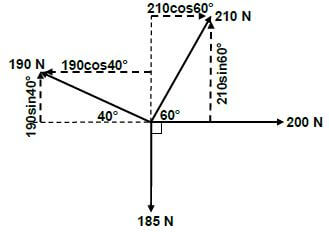
- ∑HC = 200 + 210cos60 - 190cos 40º ✔
= 200 + 105 - 145.55 ✔ ✔ ✔
= 159,45 N ✔ (4) - ∑VC = 210sin 60º + 190sin 40º - 185
= 181,87 + 122,13 - 185 ✔✔
= 119 N ✔ (3)
OR
Horizontal components | Magnitudes | Vertical components | Magnitudes |
200N | 200 N ✔ | 210NSin60º | 181,87N ✔ |
210N | 105 N ✔ | 190NSin40º | 122,13 N ✔ |
190N Cos40º | -145,45 N ✔ | -185 N | -185 N |
TOTAL | 159,45 N ✔ | TOTAL | 119 N ✔ |
2 2 2
- E2 = HC2 + VC2
E = √ 159,452 + 1192
E = 198,96 N ✔ ✔ (3)
(3)
Tan θ = VC✔
HC
= 119
159,45N
= 36,74º E
E = 198,96N 36,73º south of west ✔
OR
= 36º 44' minutes south of west ✔ (3)
7.2 Stress and Strain
7.2.1 Resistance area
- A = π (D2 - d2)
4
= π (0,0562 - 0,0382) ✔
4
= 1,33 × 10-3m2 ✔ (2)
7.2.2 Stress
- Stress = force
area
stress = 20 × 103
1,33 × 10-3
=15037593,98 Pa
Stress= 15,04MPa ✔(3)
7.2.3 Strain
- Strain = Δl ✔
OL
Strain = 50 - 49,975
50
Strain = 0,025
50
= 0,5 × 10-3 ✔ (3)
7.2.4 Young’s Modulus of Elasticity
- Youngs Modulus of Elasticity = Stress ✔
Strain
E = 15,04 × 106
0,5 10-3
= 30,08 × 109 Pa
= 30,08 GPa ✔ (3)
7.3 Moments
7.3 
Calculate B. Moments about A:
- ∑LHM =∑ RHM
( B × 6) = (300 × 1,5) + (850 × 3) ✔
6B = 3000 ✔
6 6
B = 500N ✔
Calculate A. Moments about B:
- ∑RHM =∑LHM
(A × 6) =(850 × 3) +(300 × 4,5) + (600 × 6)
6A = 2550 + 1350 + 3600
6A = 7500 ✔
6 6
B = 1250N ✔(6) [30]
QUESTION 8: MAINTENANCE
8.1 Reason using SAE 20W50
- This to ensure that the oil is able to satisfy the operational ✔ requirements over a range of temperature ✔ from start-up to running hot. (2)
8.2 Maintain V-belt drive systems
- Check the contact surfaces of the pulley to prevent the belt from being damaged.✔
- Check the belt condition and replace if it is worn.✔
- Correct installation procedure must be followed. ✔
- Belt drives should be well guarded to prevent foreign objects to come into contact with the belts and pulleys.✔
- Keep guard mesh free of papers, rags, etc. that can cause insufficient air flow. ✔
- Check that the belt deflection is according to specification. ✔
- Store replacement belts in a cool, well ventilated place. ✔
- Correct alignment of pulleys. ✔
(ANY 2 x 1) (2)
8.3 Flash point
- It is the lowest temperature ✔ at which the oil gives off vapours ✔ which can ignite. ✔ (3)
8.4 Maintaining cutting fluid
- Avoid contamination of the cutting fluid by draining and regularly replacing it. ✔
- Always clean the machine's splash tray of metal cutting after use. ✔
- Regularly wipe cutting fluid splashes of machine parts. ✔
- Ensure that the sump is topped up from time to time and check that there is sufficient flow of cutting fluid to the cutting tool. ✔
(ANY 2 x 1) (2)
8.5 Functions of the clutch plate
- It provides friction between the flywheel and pressure plate. ✔
- It serves as a link between the clutch and the gearbox main shaft. ✔ (2)
8.6 Reasons for skimming the flywheel
- To remove the grooves caused by the clutch plate. ✔
- To ensure a full contact surface between the flywheel and the clutch plate. ✔
- To prolong the life of the clutch plate. ✔
(ANY 2 x 1) (2)
8.7 Properties of grease
- It must be water resistant, it must not mix with water ✔
- Prevents rust/corrosion ✔
- Good for load pressures ✔
- High melting point ✔
- Low freezing point ✔
- Prevent gumming ✔
- Be able to lubricate ✔
- High viscosity ✔
(ANY 2 x 1) (2) [15]
QUESTION 9: SYSTEMS AND CONTROL
9.1 Gear drives
9.1.1 Rotation frequency of input shaft
- NA = TB × TD × TF
NF TA × TC × TE
NA = TB × TD × TF × NF
TA × TC × TE
= 30 × 46 × 80 × 160
20 × 18 × 42
= 1401,90r/min (3)
9.1.2 Velocity ratio
- VR= NA
NF
VR= 1401,90
160
= 8,76: 1 ✔ (2)
9.2 Belt drives
9.2.1 Rotation frequency of driver pulley
- NDR × DDR = NDN × DDN
NDR = NDN × DND
DDR
= 733,33 × 0,36
0,24
= 200r/min (3)
9.2.2 Power transmitted
- P = (T1 - T2)πDn
60
P= (360 - 90)π × 0,36 × 733,33
60
= 3732,20 Watts
=3,73 kW (2)
9.2.3 Belt speed
- Belt speed = πDN
60
= π × 0,36 × 733,33
60
= 13,83m.s-1 ✔ (2)
9.3 Hydraulics
9.3.1 Fluid pressure
- AB = πD2
4
= π0,042
4
= 1,26 × 10-3m2 - PB = F
AB
= 275
1,26 × 10-3
= 218253,97 pa
or
= 218,25 kPa (5)
9.3.2 Diameter of piston B
- PB =PA
PB = FB
AB
AB = FB
PB
AB = 5,56 × 103
218,25 × 103
AB = 25,48 × 10-3m2
AB = πD2
4
DB = √AB × 4
π
= √25,48 × 10-3 × 4
π
=0,18 m
or
=180 mm (4)
9.4 ABS
- ABS prevents wheels from skidding ✔ when breaking hard ✔ in difficult conditions. (2)
9.5 ECU
- Electronic Control Unit ✔ (1)
9.6 Traction Control
- Prevent wheels from spinning. ✔
- Improves road holding ✔
(ANY 1 x 1) (1) [25]
QUESTION 10: TURBINES
10.1 Reaction turbines
- Francis ✔
- Kaplan ✔
- Tyson ✔
Gorlov ✔ (ANY 2 x 1) (2)
10.2 Supercharger boost
- Boost refers to the increase in intake manifold pressure ✔ that exceeds normal atmospheric pressure✔ (2)
10.3 Blowers
- Roots ✔
- Centrifugal ✔
- Vane-type ✔
- Twin screw type ✔
(ANY 2 x 1) (2)
10.4 Gas turbine
- A = Clean air inlet ✔
- B = Compression ✔
- C = Combustion ✔
- D = Exhaust ✔
- E = Turbine ✔
- F = Combustion chamber ✔ (6)
10.5 Application of a gas turbine
- Jet engines ✔
- Naval ships ✔
- Hi-performance vehicles and boats ✔
- Generating electricity ✔
(ANY 2 x 1) (2)
10.6 Advantages of a gas turbine
- Less complex than internal combustion piston engines ✔
- Only one moving part (Common shaft for: compressor and turbine) ✔
- Operate at higher revolutions per minute ✔ (ANY 2 x 1) (2)
10.7 Waste gate
- A waste gate is a valve that diverts exhaust gases away from the turbine wheel ✔ to regulate the turbine/compressor speed and boost.✔ (2)
10.8 Oil cooler
- To cool the oil ✔ that lubricates the turbocharger bearings and shaft. ✔ (2) [20]
TOTAL: 200
MATHEMATICS PAPER 2 GRADE 12 MEMORANDUM - NSC PAST PAPERS AND MEMOS FEBRUARY/MARCH 2018
MATHEMATICS
PAPER 2
GRADE 12
NSC PAST PAPERS AND MEMOS
FEBRUARY/MARCH 2018
NOTE:
- If a candidate answers a question TWICE, only mark the FIRST attempt.
- If a candidate has crossed out an attempt of a question and not redone the question, mark the crossed out version.
- Consistent accuracy applies in ALL aspects of the marking guidelines. Stop marking at the second calculation error.
- Assuming answers/values in order to solve a problem is NOT acceptable.
| GEOMETRY | |
| S | A mark for a correct statement (A statement mark is independent of a reason.) |
| R | A mark for a correct reason |
| S/R | Award a mark if the statement AND reason are both correct. |
MEMORANDUM
QUESTION 1
Days | 1 | 2 | 3 | 4 | 5 | 6 | 7 | 8 | 9 | 10 |
Units of blood | 45 | 59 | 65 | 73 | 79 | 82 | 91 | 99 | 101 | 106 |
1.1.1 | x = 800 | ✔ 800 (addition of units) |
1.1.2 | σ =18,83 | ✔✔ answer (A) (2) |
1.1.3 | (61,17 ; 98,83) | ✔ mean – 1 SD |
1.2.1 | Skewed to the left or negatively skewed | ✔ answer (1) |
1.2.2 | A = 65 | ✔ answer |
1.3 | New total = 95 × 10 = 950 | ✔ answer (CA from 1.1.1) (1) [11] |
QUESTION 2 
2.1 | Outlier (100 ; 100) | ✔ answer (1) |
2.2 | a = 94,50273…
| ✔ value of a |
2.3 | yˆ= 2,91(240) + 94,50 (CA from 2.1) OR yˆ=793,7978142 (calculator)
| ✔ substitution ✔✔ answer in thousands of Rands (2) |
2.4 | b = 2,913729…
| ✔ value of b [8] |
QUESTION 3 
3.1 | x = 3 | ✔ answer (1) |
3.2 | mQP = tan71,57°
| ✔ mQP= tan71,57° |
3.3 | y = mx+c y − y1 = m (x − x1) | (m CA from 3.2 if > 0) |
3.4 |
| (wrong R: CA if x > 0) |
| 3.5 | tan(90° − θ) = mQR
| (wrong R: CA if x > 0) |
| 3.6 |
OR
| ✔ RN ✔ RN ✔ SR
[16] |
QUESTION 4 
4.1 | OK = √180 or 6√5 | ✔ answer (1) |
4.2 | a2 + b2 = 180
OR a2 + b2 = 180 | ✔ b in terms of a ✔ a in terms of b |
| 4.3.1 |  | ✔mPT= −2 |
| 4.3.2 |
OR
| ✔ 3MK = OK ✔ 3MK = OK ✔ 3MK = OK ✔ 3MK = OK |
| 4.3.3 | (x - (-16))2 + (y - (-8))2 = (1/3√180)2 (x + 16)2 + (y + 8)2 = 20 | ✔ LHS (CA from 4.3.2) |
| 4.4 |  Answer only: full marks (No need to simplify) | ✔✔ values |
| 4.5 | x2 + 32x + (16)2 + y2 + 16y + (8)2 = 256 +64 - 240 | ✔ equation in centre, radius form |
QUESTION 5
5.1.1 [ no calculator in 5.1] | cos2θ = - 5/6, where 2θ ∈[180°;270°]
OR sin22θ = 1 - cos22θ | ✔ diagram (3rd quadrant only)
✔sin22θ = 1 - cos22θ |
5.1.2 | cos2θ =1− 2sin2θ | ✔cos2θ =1− 2sin2θ |
5.2 | sin(180° − x).cos(−x) + cos(90° + x).cos(x −180°)
| ✔sin x |
5.3 | sin3x.cos y + cos3x.sin y | ✔ compound angle |
5.4.1 | 2cos x = 3tan x | ✔ tan x = sin x |
5.4.2 | 2sin2x + 3sin x - 2 = 0 | ✔ factors |
5.4.3 | 5y = 30º + k.360º or 5y = 150º + k.360º OR 144° ≤ y ≤ 216° | ✔y = 6°+ k.72° ✔ 5y = 750° |
5.5.1 | g(x) = −4cos(x + 30°) | ✔ answer (1) |
5.5.2 | range of g(x): | ✔ range of g(x) |
5.5.3 | y = −4cos(x + 30°) | ✔ shift of 60° to the left |
QUESTION 6
6.1.1 | tan θ = PQ = PQ OR = PQ | ✔ trig ratio ✔ trig ratio |
6.1.2 | AR = QR | ✔ use of sine rule |
| 6.2 | sin2θ = AB AR AB = ARsin2θ = xsin(90º + θ ).sin2θ sinθ = xcosθ .sin2θ sinθ = xcosθ .2sinθ cosθ sinθ = 2x cos2θ | ✔ substitution into trig ratio and AB as subject |
| 6.3 | AB = 2cos212º QP xtan12º = 9 | ✔ substitution CA from 6.1.1) |
QUESTION 7 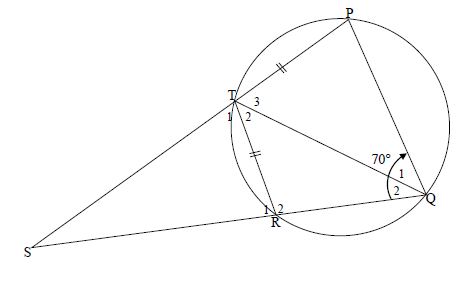
7.1.1 | T1 = 70° [ext ∠ of cyclic quad] T 70 | ✔ S ✔ R (2) |
7.1.2 | Q1 = Q2 = 35º [equal chords;equal∠s/] | ✔ S ✔ R (2) |
7.2.1 | T2 =Q1 = 35º [alt ∠s ; PQ || TR] | ✔ S ✔ R (2) |
7.2.2 | PT= QR [prop theorem ; PQ || TR] | ✔ S ✔ R (2) [8] |
QUESTION 8
| 8 | PTR = 90° [∠ in semi-circlel] | ✔ S/R |
QUESTION 9 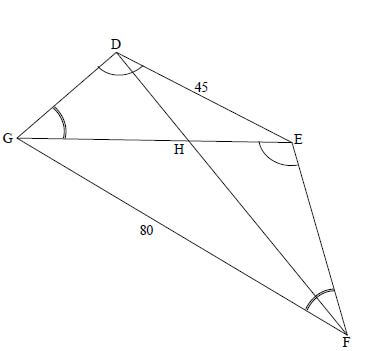
9.1 | equiangular ∆s OR (∠∠∠) | ✔ answer (1) |
9.2 | ∴ GE = DE [||| Δs] | ✔ proportion |
9.3 | In ΔDEH and ΔFGH: OR In ΔDEH and ΔFGH: | ✔ S/R ✔ S/R |
9.4 | GH = FG [||| Δs] | ✔S [10] |
QUESTION 10 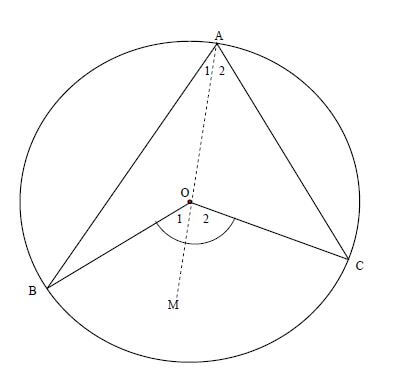
10.1 | Construction: | ✔ Constr ✔ S/R ✔ S/R ✔ S ✔ S (5) |
10.2 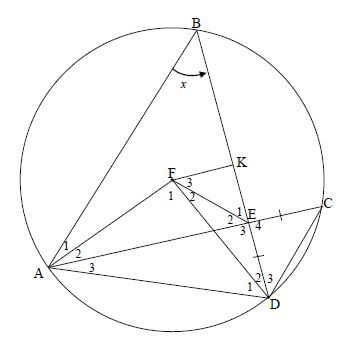
10.2.1(a) | F1 = 2x [∠ centre = 2∠ at circum ] | ✔ S ✔ R (2) |
10.2.1(b) | C = x [∠s in the same seg] OR C = x [∠ centre = 2∠ at circum] | ✔ S ✔ R (2) ✔ S ✔ R (2) |
10.2.2 | D3 = x [∠s opp equal sides] | ✔ S/R |
10.2.3 | A2 + A3 + D1 + F1= 180° [sum of ∠s in ∆] | ✔ S |
10.2.4 | BAC = D3 [∠s in the same seg] | ✔ S [24] |
TOTAL: 150
MATHEMATICS PAPER 1 GRADE 12 MEMORANDUM - NSC PAST PAPERS AND MEMOS FEBRUARY/MARCH 2018
MATHEMATICS
PAPER 1
GRADE 12
NSC PAST PAPERS AND MEMOS
FEBRUARY/MARCH 2018
MEMORANDUM
NOTE:
- If a candidate answers a question TWICE, only mark the FIRST attempt.
- Consistent accuracy applies in ALL aspects of the marking guidelines.
| QUESTION 1 | ||
1.1.1 | x2 - 6x - 16 = 0 | ✔ factors |
1.1.2 | 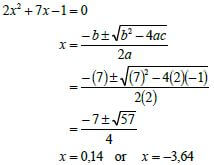 NOTE: Penalise 1 mark if the rounding to TWO decimal places is incorrect. | ✔subs into correct formula OR |
1.2 |  | ✔factors |
| 1.3 | x = 2y -1 OR
| ✔x = 2y −1 OR ✔ y = x + 1 |
| 1.4 |   | ✔ common factor 32017 OR ✔ common factor 32016 OR ✔ dividing by 32017 |
| 1.5.1 | 3x - 5 ≥ 0 and x # 3 x ≥ 5/3 and x # 3 | ✔3x −5 ≥ 0 |
| 1.5.2 | 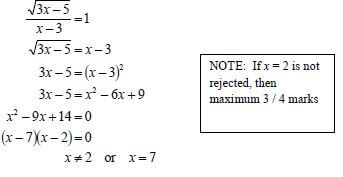 | ✔ √3x −5 = x −3 [26] |
| QUESTION 2 | ||
2.1.1 | 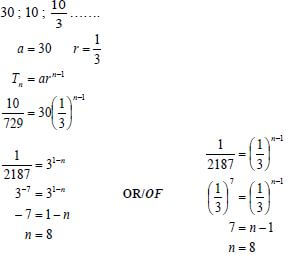 | ✔ r = 1/3 |
2.1.2 | S∞ = a | ✔substitution into correct formula |
2.2 | 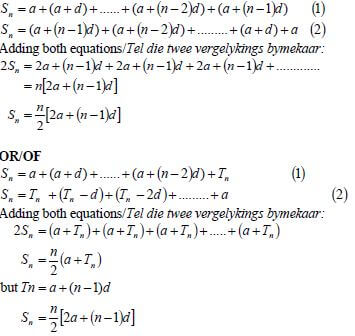 | ✔expandingn Sn [10] |
| QUESTION 3 | ||
3.1 | – 1 ; 2 ; 5 | ✔ 3n |
3.2 | T43 = 3(43) - 4 OR T43 = -1 + (43 - 1)(3) | ✔ subs of 43 |
3.3 |  | 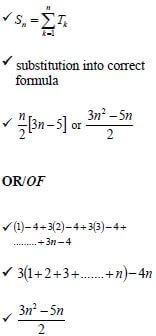 |
| 3.4 | T11 = (T11 - T10) + (T10 - T9) + (T9 - T8) + ..... + (T3 - T2) + (T2 - T1) + T1 NOTE: Answer only 1/6. OR Tn = an2 +bn + c | ✔✔ generating sum OR ✔121a +11b+c =125 [13] |
| QUESTION 4 | ||
4.1 | E(4 ; –9) | ✔ x = 4 |
4.2 | f(x) = (x - 4)2 - 9 OR f(x) = (x - 4)2 - 9 | ✔ y = 0 OR ✔ y = 0 |
4.3 | C(0 ;7) | ✔C(0 ;7) |
4.4 | C(0 ;7) | ✔D(4 ; 0) |
4.5 |
OR
| ✔ interchange x and y OR ✔ straight line through (0 ; 4) and ( 7 ; 0) |
| 4.6 | x . f (x) ≤ 0 | ✔✔x ≤ 0 [18] |
| QUESTION 5 | ||
5.1 | aº = 1 | ✔ x = 0 |
5.2 | g(x) = ax | ✔ substitution |
5.3 | y = (1/3)x or y = 3-x | ✔✔ y = (1/3)x (2) |
5.4 |
| ✔1< x OR ✔ 1 < x [8] |
| QUESTION 6 | ||
6.1 | q = 1 | ✔q =1 (1) |
6.2 |
| ✔ 0 = a + 1 |
6.3 |
| ✔y = 1 [10] |
| QUESTION 7 | ||
7.1 |
| ✔ n = 60 and i = 0,06 / 0,005 |
7.2.1 | After eleven months, Genevieve will owe: | ✔ n = 11 |
7.2.2 |
| ✔ 94006,79 |
| 7.2.3 |  | ✔ n = - 083826912 OR
[16] |
| QUESTION 8 |
 |
| QUESTION 9 | ||
9.1 | f(x) = (x + 2)(x - 1)(x - 4) | ✔✔f (x) = (x + 2)(x −1)(x − 4) |
9.2 |
| ✔ f'(x) = 0 |
9.3 | f(x) = x3 - 3x2 - 6x + 8 f(-1) = (-1)3 - 3(-1)2 - 6(-1) + 8 or f(-1) = (1)(-2)(-5) = 10 = 10 f'(-1) = 3 (-1)2 - 6(-1) - 6 = 3 y - 10 = 3(x + 1) y = 3x + 13 | ✔f' (−1) =10 |
9.4 |
| ✔ f//(x) = 6x − 6 |
| 9.5 | f concave upwards NOTE: A nswer only 2/2 | ✔ f''(x) > 0 [17] |
| QUESTION 10 | ||
| 10 |  | |
| QUESTION 11 | ||
11.1.1 | Let the event Veli arrive late for school be V. | ✔ answer (1) |
11.1.2 | P(V or B) = P(V) +P(B) - P(V and B) | ✔ P(V or B) = P(V) +P(B) –P(V and B) |
11.1.3 | P(V) × P(B) = 0,25 × 0,2 | ✔P(V) × P(B) = 0,05 |
11.2.1 | 6 ! =720 | ✔6! or 720 (2) |
11.2.2 | Number of arrangements | ✔3!× 3! |
11.2.3 | P(hearts next to each other) = 3! × 4! OR P(hearts next to each other) = 4 × 3! × 3! | ✔ ✔3!× 4! OR ✔ ✔ [15] |
TOTAL: 150
MATHEMATICS PAPER 1 GRADE 12 QUESTIONS - NSC PAST PAPERS AND MEMOS FEBRUARY/MARCH 2018
MATHEMATICS
PAPER 1
GRADE 12
NSC PAST PAPERS AND MEMOS
FEBRUARY/MARCH 2018
INSTRUCTIONS AND INFORMATION
Read the following instructions carefully before answering the questions.
- This question paper consists of 11 questions.
- Answer ALL the questions.
- Number the answers correctly according to the numbering system used in this question paper.
- Clearly show ALL calculations, diagrams, graphs, et cetera that you have used in determining your answers.
- Answers only will NOT necessarily be awarded full marks
- You may use an approved scientific calculator (non-programmable and non-graphical), unless stated otherwise.
- If necessary, round off answers to TWO decimal places, unless stated otherwise.
- Diagrams are NOT necessarily drawn to scale.
- An information sheet with formulae is included at the end of the question paper.
- Write neatly and legibly.
QUESTIONS
QUESTION 1
1.1 Solve for x:
1.1.1 x2 - 6x —16 = 0 (3)
1.1.2 2x2 + 7x —1= 0 (correct to TWO decimal places) (4)
1.2 List all the integers that are solutions to x2 — 25 < 0 (4)
1.3 Solve for x and y:
-2y + x = -1 and x2 - 7 - y2 = -y (6)
1.4 Evaluate: 32018 +32016 (2)
32017
1.5 Given: t (x) = √3x - 5
x - 3
1.5.1 For which values of x will √3x - 5 be real? (3)
x - 3
1.5.2 Solve for x if t (x) =1. (4) [26]
QUESTION 2
2.1 Given the following geometric sequence: 30 ; 10 ; 10/3 ; ............
2.1.1 Determine n if the nth term of the sequence is equal to 10 (4)
729
2.1.2 Calculate: 30 + 10 + 10/3 + ......... (2)
2.2 Derive a formula for the sum of the first n terms of an arithmetic sequence if the first term of the sequence is a and the common difference is d. (4) [10]
QUESTION 3
The first three terms of an arithmetic sequence are -1 ; 2 and 5.
3.1 Determine the nth term, Tn , of the sequence.
3.2 Calculate T43.
3.3 Evaluate in terms of n.
3.4 A quadratic sequence, with general term Tn , has the following properties:
- T11 =125
- Tn - Tn-1 = 3n - 4
Determine the first term of the sequence. (6) [13]
QUESTION 4
Below are the graphs of f (x) = (x- 4)2 — 9 and a straight line g.
- A and B are the x-intercepts of f and E is the turning point of f
- C is the y-intercept of both f and g.
- The x-intercept of g is D. DE is parallel to the y-axis.
4.1 Write down the coordinates of E. (2)
4.2 Calculate the coordinates of A. (3)
4.3 M is the reflection of C in the axis of symmetry of f Write down the coordinates of M. (3)
4.4 Determine the equation of g in the form y = mx + c (3)
4.5 Write down the equation of g-1 in the form y = (3)
4.6 For which values of x will x(f (x)) ≤ 0 ? (4) [18]
QUESTION 5
The graph of g(x)= ax is drawn in the sketch below. The point S(2 ; 9) lies on g. T is the y-intercept of g.
5.1 Write down the coordinates of T. (2)
5.2 Calculate the value of a. (2)
5.3 The graph h is obtained by reflecting g in the y-axis. Write down the equation of h (2)
5.4 Write down the values of x for which q < log3 x < 1. (2) [8]
QUESTION 6
The function f , defined by f (x) = a + q , has the following properties:
x + P
- The range of f is y ∈ R, y #1.
- The graph f passes through the origin.
- P(√2 + 2; √2 + 1) lies on the graph f.
6.1 Write down the value of q. (1)
6.2 Calculate the values of a and p. (5)
6.3 Sketch a neat graph of this function. Your graph must include the asymptotes, if any. (4) [10]
QUESTION 7
7.1On 30 June 2013 and at the end of each month thereafter, Asif deposited R2 500 into a bank account that pays interest at 6% per annum, compounded monthly. He wants to continue to deposit this amount until 31 May 2018. Calculate how much money Asif will have in this account immediately after depositing R2 500 on 31 May 2018.(3)
7.2 On 1 February 2018, Genevieve took a loan of R82 000 from the bank to pay for her studies. She will make her first repayment of R3 200 on 1 February 2019 and continue to make payments of R3 200 on the first of each month thereafter until she settles the loan. The bank charges interest at 15% per annum, compounded monthly.
7.2.1 Calculate how much Genevieve will owe the bank on 1 January 2019. (3)
7.2.2 How many instalments of R3 200 must she pay? (5)
7.2.3Calculate the final payment, to the nearest rand, Genevieve has to pay to settle the loan. (5) [16]
QUESTION 8
8.1 Determine f ' (x) from first principles if f (x) = 4x2 .
8.2 Determine:
QUESTION 9
The sketch below represents the curve of f (x) = x3 + b x2 + cx + d . The solutions of the equation f(x)= 0 are -2 ; 1 and 4.
9.1 Calculate the values of b, c and d. (4)
9.2 Calculate the x-coordinate of B, the maximum turning point of f (4)
9.3 Determine an equation for the tangent to the graph of f at x = -1. (4)
9.4 In the ANSWER BOOK, sketch the graph of f'' (x). Clearly indicate the x- and y-intercepts on your sketch. (3)
9.5 For which value(s) of x is f (x) concave upwards? (2) [17]
QUESTION 10
Given: f(x)=-3x3 + x .
Calculate the value of q for which f (x) + q will have a maximum value of 8/9 [6]
QUESTION 11
11.1 Veli and Bongi are learners at the same school. Some days they arrive late at school. The probability that neither Veli nor Bongi will arrive late on any day is 0,7.
11.1.1 Calculate the probability that at least one of the two learners will arrive late on a randomly selected day. (1)
11.1.2 The probability that Veli arrives late for school on a randomly selected day is 0,25, while the probability that both of them arrive late for school on that day is 0,15. Calculate the probability that Bongi will arrive late for school on that day. (3)
11.1.3 The principal suspects that the latecoming of the two learners is linked. The principal asks you to determine whether the events of Veli arriving late for school and Bongi arriving late for school are statistically independent or not. What will be your response to him? Show ALL calculations. (3)
11.2The cards below are placed from left to right in a row.
11.2.1 In how many different ways can these 6 cards be randomly arranged in a row? (2)
11.2.2 In how many different ways can these cards be arranged in a row if the diamonds and hearts are placed in alternating positions? (3)
11.2.3 If these cards are randomly arranged in a row, calculate the probability that ALL the hearts will be next to one another. (3)
[15]
TOTAL: 150
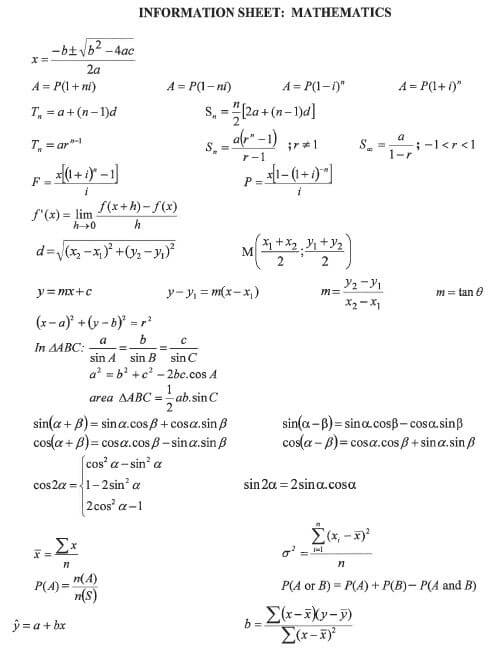
 (3)
(3) 
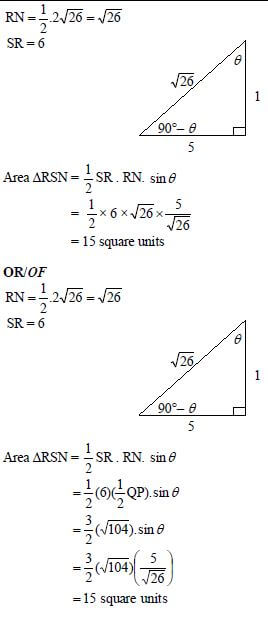
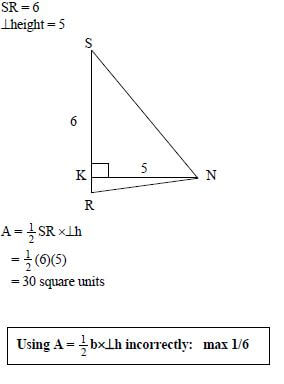
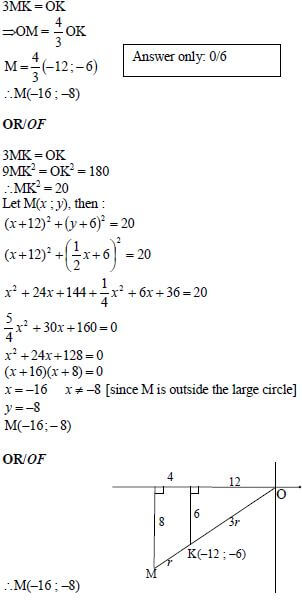
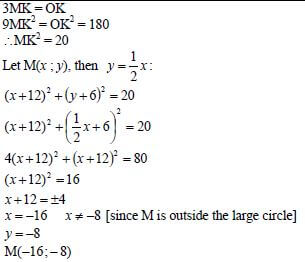
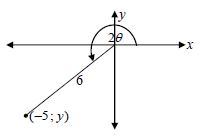
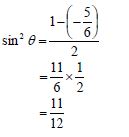
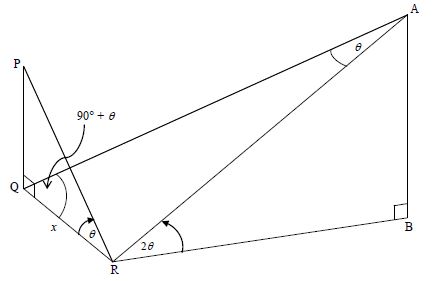
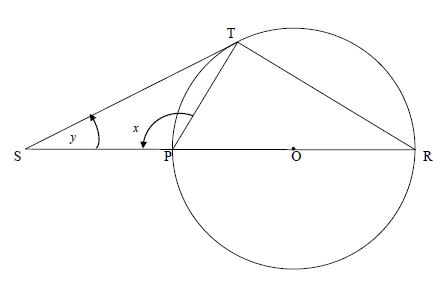
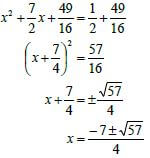
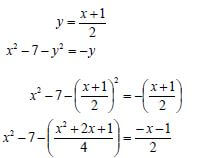

 (4)
(4) 

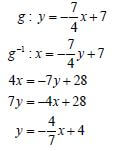
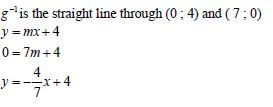
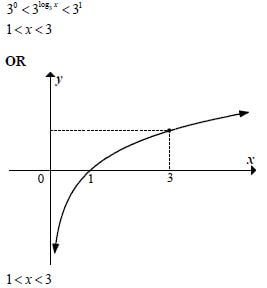

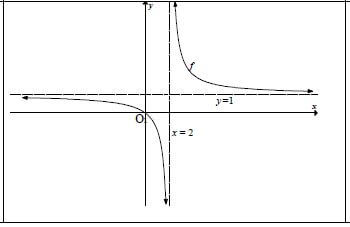


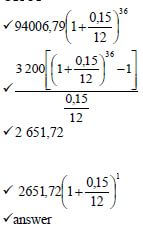 (5)
(5)
